Knowledge Bases in the Age of Big Data

Knowledge Bases in the Age of Big Data Analytics Fabian Suchanek Gerhard Weikum Télécom Paris. Tech University http: //suchanek. name/ Max Planck Institute for Informatics http: //mpi-inf. mpg. de/~weikum http: //resources. mpi-inf. mpg. de/yago-naga/vldb 2014 -tutorial/

Turn Web into Knowledge Base more knowledge, analytics, insight knowledge acquisition Web Contents Knowledge intelligent interpretation

Web of Data & Knowledge (Linked Open Data) > 60 Bio. subject-predicate-object triples from > 1000 sources + Web tables Read. The. Web Cyc Babel. Net SUMO Text. Runner/ Re. Verb Concept. Net 5 Wiki. Taxonomy/ Wiki. Net http: //richard. cyganiak. de/2007/10/lod-datasets_2011 -09 -19_colored. png

Web of Data & Knowledge > 60 Bio. subject-predicate-object triples from > 1000 sources • 10 M entities in 350 K classes • 120 M facts for 100 relations • 100 languages • 95% accuracy • 4 M entities in 250 classes • 500 M facts for 6000 properties • live updates • 600 M entities in 15000 topics • 20 B facts • 40 M entities in 15000 topics • 1 B facts for 4000 properties • core of Google Knowledge Graph

Web of Data & Knowledge > 60 Bio. subject-predicate-object triples from > 1000 sources Yimou_Zhang type movie_director taxonomic knowledge Yimou_Zhang type olympic_games_participant movie_director subclass. Of artist Yimou_Zhang directed Flowers_of_War factual knowledge Christian_Bale acted. In Flowers_of_War temporal knowledge id 11: Yimou_Zhang member. Of Beijing_film_academy id 11 valid. During [1978, 1982] Yimou_Zhang http: //richard. cyganiak. de/2007/10/lod-datasets_2011 -09 -19_colored. png „was classmate of“ Kaige_Chen emerging knowledge Yimou_Zhang „had love affair with“ Li_Gong D 5 Overview most May 14, 2013 terminological knowledge 5 Li_Gong known. As „China‘s beautiful“

Knowledge Bases: a Pragmatic Definition Comprehensive and semantically organized machine-readable collection of universally relevant or domain-specific entities, classes, and SPO facts (attributes, relations) plus spatial and temporal dimensions plus commonsense properties and rules plus contexts of entities and facts (textual & visual witnesses, descriptors, statistics) plus …. .

History of Digital Knowledge Bases Cyc Word. Net from humans for humans guitarist {player, musician} artist algebraist Ì mathematician Ì scientist x: human(x) ( y: mother(x, y) z: father(x, z)) x, u, w: (mother(x, u) mother(x, w) u=w) 1985 1990 from algorithms for machines Wikipedia 4. 5 Mio. English articles 20 Mio. contributors 2000 2005 2010

Some Publicly Available Knowledge Bases YAGO: Dbpedia: Freebase: Entitycube: yago-knowledge. org dbpedia. org freebase. com entitycube. research. microsoft. com renlifang. msra. cn NELL: rtw. ml. cmu. edu Deep. Dive: deepdive. stanford. edu Probase: research. microsoft. com/en-us/projects/probase/ Know. It. All / Re. Verb: openie. cs. washington. edu reverb. cs. washington. edu Babel. Net: babelnet. org Wiki. Net: www. h-its. org/english/research/nlp/download/ Concept. Net: conceptnet 5. media. mit. edu Word. Net: wordnet. princeton. edu Linked Open Data: linkeddata. org 8

Knowledge for Intelligence Enabling technology for: disambiguation in written & spoken natural language deep reasoning (e. g. QA to win quiz game) machine reading (e. g. to summarize book or corpus) semantic search in terms of entities&relations (not keywords&pages) entity-level linkage for Big Data Politicians who are also scientists? European composers who have won film music awards? Chinese professors who founded Internet companies? Relationships between John Lennon, Billie Holiday, Heath Ledger, King Kong? Enzymes that inhibit HIV? Influenza drugs for teens with high blood pressure? . . . 9

Use-Case: Internet Search

Google Knowledge Graph (Google Blog: „Things, not Strings“, 16 May 2012)

Use Case: Question Answering This town is known as "Sin City" & its downtown is "Glitter Gulch" Q: Sin City ? movie, graphical novel, nickname for city, … A: Vegas ? Strip ? Vega (star), Suzanne Vega, Vincent Vega, Las Vegas, … comic strip, striptease, Las Vegas Strip, … This American city has two airports named after a war hero and a WW II battle question classification & decomposition knowledge back-ends D. Ferrucci et al. : Building Watson. AI Magazine, Fall 2010. IBM Journal of R&D 56(3/4), 2012: This is Watson. 12

Use Case: Text Analytics (Disease Networks) add genetic & pathway data, patient data, reports in social media, etc. → bottlenecks: data variety & data veracity → key asset: digital background knowledge for data cleaning, fusion, sense-making But try this with: need to understand synonyms vs. homonyms of entities & relations (Google: „things, not strings“) diabetes mellitus, diabetis type 1, diabetes type 2, diabetes insipidus, insulin-dependent diabetes mellitus with ophthalmic complications, ICD-10 E 23. 2, OMIM 304800, Me. SH C 18. 452. 394. 750, Me. SH D 003924, … K. Goh, M. Kusick, D. Valle, B. Childs, M. Vidal, A. Barabasi: The Human Disease Network, PNAS, May 2007

Use Case: Big Data Analytics (Side Effects of Drug Combinations) Structured Expert Data Deeper insight from both expert data & social media: • actual side effects of drugs • … and drug combinations • risk factors and complications of (wide-spread) diseases • alternative therapies • aggregation & comparison by age, gender, life style, etc. Social Media harness knowledge base(s) on diseases, symptoms, drugs, biochemistry, food, demography, geography, culture, life style, jobs, transportation, etc. http: //dailymed. nlm. nih. gov http: //www. patient. co. uk

Big Data+Text Analytics Health: Drugs (combinations) and their side effects Entertainment: Who covered which other singer? Who influenced which other musicians? Politics: Politicians‘ positions on controversial topics and their involvement with industry Business: Customer opinions on small-company products, gathered from social media Culturomics: Trends in society, cultural factors, etc. General Design Pattern: • Identify relevant contents sources • Identify entities of interest & their relationships • Position in time & space • Group and aggregate • Find insightful patterns & predict trends 15

Knowledge Bases & Big Data Analytics Scalable algorithms Distributed platforms Discovering data sources Tapping unstructured data Connecting structured & unstructured data sources Making sense of heterogeneous, dirty, or uncertain data Knowledge Bases: entities, relations, time, space, … 16

Outline Motivation and Overview Taxonomic Knowledge: Entities and Classes Factual Knowledge: Relations between Entities Emerging Knowledge: New Entities & Relations Big Data Methods for Knowledge Harvesting Temporal Knowledge: Validity Times of Facts Contextual Knowledge: Entity Disambiguation & Linkage Commonsense Knowledge: Knowledge for Big Data Analytics Properties & Rules Wrap-up http: //resources. mpi-inf. mpg. de/yago-naga/vldb 2014 -tutorial/

Outline Motivation and Overview Taxonomic Knowledge: Entities and Classes Factual Knowledge: Relations between Entities Scope & Goal Wikipedia-centric Methods Web-based Methods Emerging Knowledge: New Entities & Relations Temporal Knowledge: Validity Time of Facts Contextual Knowledge: Entity Disambiguation & Linkage Commonsense Knowledge: Properties & Rules Wrap-up http: //resources. mpi-inf. mpg. de/yago-naga/vldb 2014 -tutorial/

Knowledge Bases are labeled graphs resource subclass. Of person location subclass. Of singer city type born. In Tupelo Classes/ Concepts/ Types Relations/ Predicates Instances/ entities A knowledge base can be seen as a directed labeled multi-graph, where the nodes are entities and the edges relations. 19

An entity can have different labels The same entity has two labels: synonymy person singer type label “The King” The same label for two entities: ambiguity label “Elvis” 20

Different views of a knowledge base We use "RDFS Ontology" and "Knowledge Base (KB)" synonymously. Graph notation: singer Triple notation: Subject Elvis. . . Predicate type born. In. . . Object singer Tupelo. . . type Tupelo born. In Logical notation: type(Elvis, singer) born. In(Elvis, Tupelo). . . 21

Our Goal is finding classes and instances person subclass. Of Which classes exist? (aka entity types, unary predicates, concepts) Which subsumptions hold? singer type Which entities belong to which classes? Which entities exist? 22

Word. Net is a lexical knowledge base living being subclass. Of label “person” Word. Net contains 82, 000 classes person subclass. Of singer Word. Net contains thousands of subclass. Of relationships “individual” “soul” Word. Net project (1985 -now) Word. Net contains 118, 000 class labels 23

Word. Net example: superclasses 24

Word. Net example: subclasses 25

Word. Net example: instances only 32 singers !? 4 guitarists 5 scientists 0 enterprises 2 entrepreneurs Word. Net classes lack instances 26

Goal is to go beyond Word. Net is not perfect: • it contains only few instances • it contains only common nouns as classes • it contains only English labels . . . but it contains a wealth of information that can be the starting point for further extraction. 27

Outline Motivation and Overview Taxonomic Knowledge: Entities and Classes Basics & Goal Factual Knowledge: Wikipedia-centric Methods Web-based Methods Relations between Entities Emerging Knowledge: New Entities & Relations Temporal Knowledge: Validity Times of Facts Contextual Knowledge: Entity Disambiguation & Linkage Commonsense Knowledge: Properties & Rules Wrap-up http: //resources. mpi-inf. mpg. de/yago-naga/vldb 2014 -tutorial/

Wikipedia is a rich source of instances Jimmy Wales Larry Sanger 29

Wikipedia's categories contain classes But: categories do not form a taxonomic hierarchy 30

Link Wikipedia categories to Word. Net? American billionaires Technology company founders Apple Inc. Deaths from cancer ? Internet pioneers tycoon, magnate entrepreneur ? pioneer, innovator pioneer, colonist Wikipedia categories Word. Net classes 31

Categories can be linked to Word. Net singer gr. person “person” “singer” people “people” descent “descent” Most frequent meaning Head has to be plural person pre-modifier Word. Net head Stemming post-modifier American people of Syrian descent Noungroup parsing Wikipedia 32

YAGO = Word. Net+Wikipedia Related project: Wiki. Taxonomy 200, 000 classes 460, 000 subclass. Of 3 Mio. instances 96% accuracy 105, 000 subclass. Of links 88% accuracy [Ponzetto & Strube: AAAI‘ 07] organism [Suchanek: WWW‘ 07] subclass. Of Word. Net person subclass. Of American people of Syrian descent type Steve Jobs Wikipedia 33

Link Wikipedia & Word. Net by Random Walks • construct neighborhood around source and target nodes • use contextual similarity (glosses etc. ) as edge weights • compute personalized PR (PPR) with source as start node • rank candidate targets by their PPR scores causal agent Michael Schumacher motor racing chauffeur race driver Formula One drivers trucker Formula One champions truck drivers Wikipedia categories {driver, operator of vehicle} tool Barney Oldfield computer program {driver, device driver} Word. Net classes[Navigli 2010] >34
![Learning More Mappings [ Wu & Weld: WWW‘ 08 ] Kylin Ontology Generator (KOG): Learning More Mappings [ Wu & Weld: WWW‘ 08 ] Kylin Ontology Generator (KOG):](http://slidetodoc.com/presentation_image_h2/90103e2b31ead7cee92e6efcbcf159fd/image-35.jpg)
Learning More Mappings [ Wu & Weld: WWW‘ 08 ] Kylin Ontology Generator (KOG): learn classifier for subclass. Of across Wikipedia & Word. Net using • YAGO as training data • advanced ML methods (SVM‘s, MLN‘s) • rich features from various sources • category/class name similarity measures • category instances and their infobox templates: template names, attribute names (e. g. known. For) • Wikipedia edit history: refinement of categories • Hearst patterns: C such as X, X and Y and other C‘s, … • other search-engine statistics: co-occurrence frequencies > 3 Mio. entities > 1 Mio. w/ infoboxes > 500 000 categories 35

Outline Motivation and Overview Taxonomic Knowledge: Entities and Classes Factual Knowledge: Relations between Entities Basics & Goal Wikipedia-centric Methods Web-based Methods Emerging Knowledge: New Entities & Relations Temporal Knowledge: Validity Times of Facts Contextual Knowledge: Entity Disambiguation & Linkage Commonsense Knowledge: Properties & Rules Wrap-up http: //resources. mpi-inf. mpg. de/yago-naga/vldb 2014 -tutorial/ 36
![Hearst patterns extract instances from text [M. Hearst 1992] Goal: find instances of classes Hearst patterns extract instances from text [M. Hearst 1992] Goal: find instances of classes](http://slidetodoc.com/presentation_image_h2/90103e2b31ead7cee92e6efcbcf159fd/image-37.jpg)
Hearst patterns extract instances from text [M. Hearst 1992] Goal: find instances of classes Hearst defined lexico-syntactic patterns for type relationship: X such as Y; X like Y; X and other Y; X including Y; X, especially Y; Find such patterns in text: //better with POS tagging companies such as Apple Google, Microsoft and other companies Internet companies like Amazon and Facebook Chinese cities including Kunming and Shangri-La computer pioneers like the late Steve Jobs Derive type(Y, X) type(Apple, company), type(Google, company), . . . 37
![Recursivley apply doubly-anchored patterns [Kozareva/Hovy 2010, Dalvi et al. 2012] Goal: find instances of Recursivley apply doubly-anchored patterns [Kozareva/Hovy 2010, Dalvi et al. 2012] Goal: find instances of](http://slidetodoc.com/presentation_image_h2/90103e2b31ead7cee92e6efcbcf159fd/image-38.jpg)
Recursivley apply doubly-anchored patterns [Kozareva/Hovy 2010, Dalvi et al. 2012] Goal: find instances of classes Start with a set of seeds: companies = {Microsoft, Google} Parse Web documents and find the pattern W, Y and Z If two of three placeholders match seeds, harvest the third: Google, Microsoft and Amazon Cherry, Apple, and Banana type(Amazon, company) > 38
![Instances can be extracted from tables [Kozareva/Hovy 2010, Dalvi et al. 2012] Goal: find Instances can be extracted from tables [Kozareva/Hovy 2010, Dalvi et al. 2012] Goal: find](http://slidetodoc.com/presentation_image_h2/90103e2b31ead7cee92e6efcbcf159fd/image-39.jpg)
Instances can be extracted from tables [Kozareva/Hovy 2010, Dalvi et al. 2012] Goal: find instances of classes Start with a set of seeds: cities = {Paris, Shanghai, Brisbane} Parse Web documents and find tables Paris Shanghai Berlin London France China Germany UK Paris Helena Odysseus Rama Iliad Odysee Mahabaratha If at least two seeds appear in a column, harvest the others: type(Berlin, city) type(London, city) 39

Extracting instances from lists & tables [Etzioni et al. 2004, Cohen et al. 2008, Mitchell et al. 2010] State-of-the-Art Approach (e. g. SEAL): • Start with seeds: a few class instances • Find lists, tables, text snippets (“for example: …“), … that contain one or more seeds • Extract candidates: noun phrases from vicinity • Gather co-occurrence stats (seed&cand, cand&class. Name pairs) • Rank candidates • point-wise mutual information, … • random walk (PR-style) on seed-cand graph Caveats: Precision drops for classes with sparse statistics (IR profs, …) Harvested items are names, not entities Canonicalization (de-duplication) unsolved 40

Probase builds a taxonomy from the Web Use Hearst liberally to obtain many instance candidates: „plants such as trees and grass“ „plants include water turbines“ „western movies such as The Good, the Bad, and the Ugly“ Problem: signal vs. noise Assess candidate pairs statistically: P[X|Y] >> P[X*|Y] subclass. Of(Y X) Problem: ambiguity of labels Merge labels of same class: X such as Y 1 and Y 2 same sense of X > Pro. Base 2. 7 Mio. classes from 1. 7 Bio. Web pages [Wu et al. : SIGMOD 2012] 41
![Use query logs to refine taxonomy [Pasca 2011] Input: type(Y, X 1), type(Y, X Use query logs to refine taxonomy [Pasca 2011] Input: type(Y, X 1), type(Y, X](http://slidetodoc.com/presentation_image_h2/90103e2b31ead7cee92e6efcbcf159fd/image-42.jpg)
Use query logs to refine taxonomy [Pasca 2011] Input: type(Y, X 1), type(Y, X 2), type(Y, X 3), e. g, extracted from Web Goal: rank candidate classes X 1, X 2, X 3 Combine the following scores to rank candidate classes: H 1: X and Y should co-occur frequently in queries score 1(X) freq(X, Y) * #distinct. Patterns(X, Y) H 2: If Y is ambiguous, then users will query X Y: score 2(X) ( i=1. . N term-score(ti X))1/N example query: "Michael Jordan computer scientist" H 3: If Y is ambiguous, then users will query first X, then X Y: score 3(X) ( i=1. . N term-session-score(ti X))1/N 42

Take-Home Lessons Semantic classes for entities > 10 Mio. entities in 100, 000‘s of classes backbone for other kinds of knowledge harvesting great mileage for semantic search e. g. politicians who are scientists, French professors who founded Internet companies, … Variety of methods noun phrase analysis, random walks, extraction from tables, … Still room for improvement higher coverage, deeper in long tail, … 43

Open Problems and Grand Challenges Wikipedia categories reloaded: larger coverage comprehensive & consistent instance. Of and sub. Class. Of across Wikipedia and Word. Net e. g. people lost at sea, ACM Fellow, Jewish physicists emigrating from Germany to USA, … Long tail of entities beyond Wikipedia: domain-specific entity catalogs e. g. music, books, book characters, electronic products, restaurants, … New name for known entity vs. new entity? e. g. Lady Gaga vs. Radio Gaga vs. Stefani Joanne Angelina Germanotta Universal solution for taxonomy alignment e. g. Wikipedia‘s, dmoz. org, baike. baidu. com, amazon, librarything tags, … 44

Outline Motivation and Overview Taxonomic Knowledge: Entities and Classes Factual Knowledge: Relations between Entities Emerging Knowledge: New Entities & Relations Temporal Knowledge: Validity Times of Facts Scope & Goal Regex-based Extraction Pattern-based Harvesting Consistency Reasoning Probabilistic Methods Web-Table Methods Contextual Knowledge: Entity Disambiguation & Linkage Commonsense Knowledge: Properties & Rules Wrap-up http: //resources. mpi-inf. mpg. de/yago-naga/vldb 2014 -tutorial/

We focus on given binary relations Given binary relations with type signature has. Advisor: Person graduated. At: Person University has. Won. Prize: Person Award born. On: Person Date. . . find instances of these relations has. Advisor (Jim. Gray, Mike. Harrison) has. Advisor (Hector. Garcia-Molina, Gio Wiederhold) has. Advisor (Susan Davidson, Hector Garcia-Molina) graduated. At (Jim. Gray, Berkeley) graduated. At (Hector. Garcia-Molina, Stanford) has. Won. Prize (Jim. Gray, Turing. Award) born. On (John. Lennon, 9 -Oct-1940) 46

IE can tap into different sources Information Extraction (IE) from: • Semi-structured data “Low-Hanging Fruit” • Wikipedia infoboxes & categories • HTML lists & tables, etc. • Free text “Cherrypicking” • Hearst patterns & other shallow NLP • Iterative pattern-based harvesting • Consistency reasoning • Web tables 47

Source-centric IE vs. Yield-centric IE Source-centric IE Surajit obtained his Ph. D in CS from Stanford. . . 1) recall ! 2) precision Document 1: instance. Of (Surajit, scientist) in. Field (Surajit, c. science) alma. Mater (Surajit, Stanford U) … one source Yield-centric IE has. Advisor Student Advisor Surajit Chaudhuri Jeffrey Ullman Jim Gray Mike Harrison … … + (optional) targeted 1) precision ! works. At relations 2) recall many sources Student Surajit Chaudhuri Jim Gray … University Stanford U UC Berkeley … 48

We focus on yield-centric IE Yield-centric IE has. Advisor Student Advisor Surajit Chaudhuri Jeffrey Ullman Jim Gray Mike Harrison … … + (optional) targeted 1) precision ! works. At relations 2) recall many sources Student Surajit Chaudhuri Jim Gray … University Stanford U UC Berkeley … 49

Outline Motivation and Overview Taxonomic Knowledge: Entities and Classes Factual Knowledge: Relations between Entities Scope & Goal Emerging Knowledge: Regex-based Extraction Pattern-based Harvesting Consistency Reasoning Probabilistic Methods Web-Table Methods New Entities & Relations Temporal Knowledge: Validity Times of Facts Contextual Knowledge: Entity Disambiguation & Linkage Commonsense Knowledge: Properties & Rules Wrap-up http: //resources. mpi-inf. mpg. de/yago-naga/vldb 2014 -tutorial/

Wikipedia provides data in infoboxes 51

Wikipedia uses a Markup Language {{Infobox scientist | name = James Nicholas "Jim" Gray | birth_date = {{birth date|1944|1|12}} | birth_place = [[San Francisco, California]] | death_date = ('''lost at sea''') {{death date|2007|1|28|1944|1|12}} | nationality = American | field = [[Computer Science]] | alma_mater = [[University of California, Berkeley]] | advisor = Michael Harrison. . . 52

Infoboxes are harvested by Reg. Ex {{Infobox scientist | name = James Nicholas "Jim" Gray | birth_date = {{birth date|1944|1|12}} Map attribute to canoncial, predefined relation (manually or crowd-sourced) Extract data item by regular expression was. Born 1944 -01 -12 was. Born(Jim_Gray, "1944 -01 -12") 53

Learn how articles express facts James "Jim" Gray (born January 12, 1944 find attribute value in full text learn pattern XYZ (born MONTH DAY, YEAR 54

Extract from articles w/o infobox Rakesh Agrawal (born April 31, 1965). . . propose attribute value. . . Name: R. Agrawal Birth date: ? apply pattern XYZ (born MONTH DAY, YEAR. . . and/or build fact born. On. Date(R. Agrawal, 1965 -04 -31) [Wu et al. 2008: "KYLIN"] 55

Use CRF to express patterns James "Jim" Gray (born January 12, 1944 James "Jim" Gray (born in January, 1944 OTH OTH OTH VAL Features can take into account • token types (numeric, capitalization, etc. ) • word windows preceding and following position • deep-parsing dependencies • first sentence of article • membership in relation-specific lexicons [R. Hoffmann et al. 2010: "Learning 5000 Relational Extractors] 56

Outline Motivation and Overview Taxonomic Knowledge: Entities and Classes Factual Knowledge: Relations between Entities Emerging Knowledge: New Entities & Relations Temporal Knowledge: Validity Times of Facts Contextual Knowledge: Scope & Goal Regex-based Extraction Pattern-based Harvesting Consistency Reasoning Probabilistic Methods Web-Table Methods Entity Disambiguation & Linkage Commonsense Knowledge: Properties & Rules Wrap-up http: //resources. mpi-inf. mpg. de/yago-naga/vldb 2014 -tutorial/

Facts yield patterns – and vice versa Facts & Fact Candidates Patterns (Jim. Gray, Mike. Harrison) X and his advisor Y (Barbara. Liskov, John. Mc. Carthy) X under the guidance of Y (Surajit, Jeff) (Alon, Jeff) (Sunita, Mike) (Renee, Yannis) (Sunita, Soumen) (Soumen, Sunita) (Surajit, Moshe) (Alon, Larry) (Surajit, Microsoft) X and Y in their paper X co-authored with Y X rarely met his advisor Y … • good for recall • noisy, drifting • not robust enough for high precision 58

Statistics yield pattern assessment Support of pattern p: # occurrences of p with seeds (e 1, e 2) # occurrences of all patterns with seeds Confidence of pattern p: # occurrences of p with seeds (e 1, e 2) # occurrences of p Confidence of fact candidate (e 1, e 2): p freq(e 1, p, e 2)*conf(p) / p freq(e 1, p, e 2) or: PMI (e 1, e 2) = log freq(e 1, e 2) freq(e 1) freq(e 2) • gathering can be iterated, • can promote best facts to additional seeds for next round 59

Negative Seeds increase precision (Ravichandran 2002; Suchanek 2006; . . . ) Problem: Some patterns have high support, but poor precision: X is the largest city of Y for is. Capital. Of (X, Y) joint work of X and Y for has. Advisor (X, Y) Idea: Use positive and negative seeds: pos. seeds: (Paris, France), (Rome, Italy), (New Delhi, India), . . . neg. seeds: (Sydney, Australia), (Istanbul, Turkey), . . . Compute the confidence of a pattern as: # occurrences of p with pos. seeds or neg. seeds • can promote best facts to additional seeds for next round • can promote rejected facts to additional counter-seeds • works more robustly with few seeds & counter-seeds > 60

Generalized patterns increase recall (N. Nakashole 2011) Problem: Some patterns are too narrow and thus have small recall: X and his celebrated advisor Y X carried out his doctoral research in math under the supervision of Y X received his Ph. D degree in the CS dept at Y X obtained his Ph. D degree in math at Y Idea: generalize patterns to n-grams, allow POS tags X { his doctoral research, under the supervision of} Y X { PRP ADJ advisor } Y X { PRP doctoral research, IN DET supervision of} Y Compute n-gram-sets by frequent sequence mining Compute match quality of pattern p with sentence q by Jaccard: |{n-grams p} {n-grams q]| => Covers more sentences, increases recall > 61

Deep Parsing makes patterns robust (Bunescu 2005 , Suchanek 2006, …) Problem: Surface patterns fail if the text shows variations Cologne lies on the banks of the Rhine. Paris, the French capital, lies on the beautiful banks of the Seine. Idea: Use deep linguistic parsing to define patterns Cologne lies on the banks of the Rhine Ss MVp DMc Jp Mp Dg Js Deep linguistic patterns work even on sentences with variations Paris, the French capital, lies on the beautiful banks of the Seine 62

Outline Motivation and Overview Taxonomic Knowledge: Entities and Classes Factual Knowledge: Relations between Entities Emerging Knowledge: New Entities & Relations Temporal Knowledge: Validity Times of Facts Contextual Knowledge: Scope & Goal Regex-based Extraction Pattern-based Harvesting Consistency Reasoning Probabilistic Methods Web-Table Methods Entity Disambiguation & Linkage Commonsense Knowledge: Properties & Rules Wrap-up http: //resources. mpi-inf. mpg. de/yago-naga/vldb 2014 -tutorial/

Extending a KB faces 3+ challenges (F. Suchanek et al. : WWW‘ 09) Problem: If we want to extend a KB, we face (at least) 3 challenges 1. Understand which relations are expressed by patterns "x is married to y“ spouse(x, y) 2. Disambiguate entities "Hermione is married to Ron": "Ron" = Ronald. Reagan? 3. Resolve inconsistencies spouse(Hermione, Reagan) & spouse(Reagan, Davis) ? type (Reagan, president) spouse (Reagan, Davis) spouse (Elvis, Priscilla) "Hermione is married to Ron" ? 64

SOFIE transforms IE to logical rules (F. Suchanek et al. : WWW‘ 09) Idea: Transform corpus to surface statements "Hermione is married to Ron" occurs("Hermione", "is married to", "Ron") Add possible meanings for all words from the KB means("Ron", Ronald. Reagan) means("Ron", Ron. Weasley) Only one of these can be true means("Hermione", Hermione. Granger) means(X, Y) & means(X, Z) Y=Z Add pattern deduction rules occurs(X, P, Y) & means(X, X') & means(Y, Y') & R(X', Y') P~R occurs(X, P, Y) & means(X, X') & means(Y, Y') & P~R R(X', Y') Add semantic constraints (manually) spouse(X, Y) & spouse(X, Z) Y=Z 65

The rules deduce meanings of patterns (F. Suchanek et al. : WWW‘ 09) type(Reagan, president) spouse(Reagan, Davis) spouse(Elvis, Priscilla) "Elvis is married to Priscilla" "is married to“ ~ spouse Add pattern deduction rules occurs(X, P, Y) & means(X, X') & means(Y, Y') & R(X', Y') P~R occurs(X, P, Y) & means(X, X') & means(Y, Y') & P~R R(X', Y') Add semantic constraints (manually) spouse(X, Y) & spouse(X, Z) Y=Z 66

The rules deduce facts from patterns (F. Suchanek et al. : WWW‘ 09) type(Reagan, president) spouse(Reagan, Davis) spouse(Elvis, Priscilla) "Hermione is married to Ron" "is married to“ ~ married spouse(Hermione, Ronald. Reagan) spouse(Hermione, Ron. Weasley) Add pattern deduction rules occurs(X, P, Y) & means(X, X') & means(Y, Y') & R(X', Y') P~R occurs(X, P, Y) & means(X, X') & means(Y, Y') & P~R R(X', Y') Add semantic constraints (manually) spouse(X, Y) & spouse(X, Z) Y=Z 67

The rules remove inconsistencies (F. Suchanek et al. : WWW‘ 09) type(Reagan, president) spouse(Reagan, Davis) spouse(Elvis, Priscilla) spouse(Hermione, Ronald. Reagan) spouse(Hermione, Ron. Weasley) Add pattern deduction rules occurs(X, P, Y) & means(X, X') & means(Y, Y') & R(X', Y') P~R occurs(X, P, Y) & means(X, X') & means(Y, Y') & P~R R(X', Y') Add semantic constraints (manually) spouse(X, Y) & spouse(X, Z) Y=Z 68

The rules pose a weighted Max. Sat problem (F. Suchanek et al. : WWW‘ 09) type(Reagan, president) married(Reagan, Davis) married(Elvis, Priscilla) We are given a set of rules/facts, and wish to find the most plausible possible world. [10] spouse(X, Y) & spouse(X, Z) => Y=Z [10] occurs("Hermione", "loves", "Harry") [3] means("Ron", Ronald. Reagan) [3] means("Ron", Ronald. Weasley) [2]. . . Possible World 1: married Weight of satisfied rules: 30 Possible World 2: married > Weight of satisfied rules: 39

PROSPERA parallelizes the extraction (N. Nakashole et al. : WSDM‘ 11) occurs() spouse() loves() Mining the pattern occurrences is embarassingly parallel Reasoning is hard to parallelize as atoms depends on other atoms occurs() loves() means() Idea: parallelize along min-cuts 70

Outline Motivation and Overview Taxonomic Knowledge: Entities and Classes Factual Knowledge: Relations between Entities Emerging Knowledge: New Entities & Relations Temporal Knowledge: Validity Times of Facts Contextual Knowledge: Scope & Goal Regex-based Extraction Pattern-based Harvesting Consistency Reasoning Probabilistic Methods Web-Table Methods Entity Disambiguation & Linkage Commonsense Knowledge: Properties & Rules Wrap-up http: //resources. mpi-inf. mpg. de/yago-naga/vldb 2014 -tutorial/

Markov Logic generalizes Max. Sat reasoning (M. Richardson / P. Domingos 2006) In a Markov Logic Network (MLN), every atom is represented by a Boolean random variable. spouse() loves() X 1 X 3 occurs() loves() X 2 means() X 4 X 5 means() X 6 X 7 72

Dependencies in an MLN are limited The Hammersley-Clifford Theorem tells us: X 2 X 1 X 3 X 4 X 5 X 6 X 7 73

There are many methods for MLN inference To compute the values that maximize the joint probability (MAP = maximum a posteriori) we can use a variety of methods: Gibbs sampling, other MCMC, belief propagation, randomized Max. Sat, … In addition, the MLN can model/compute • marginal probabilities • the joint distribution X 2 X 1 X 3 X 4 X 5 X 6 X 7 > 74
![Large-Scale Fact Extraction with MLNs [J. Zhu et al. : WWW‘ 09] Stat. Snowball: Large-Scale Fact Extraction with MLNs [J. Zhu et al. : WWW‘ 09] Stat. Snowball:](http://slidetodoc.com/presentation_image_h2/90103e2b31ead7cee92e6efcbcf159fd/image-75.jpg)
Large-Scale Fact Extraction with MLNs [J. Zhu et al. : WWW‘ 09] Stat. Snowball: • start with seed facts and initial MLN model • iterate: • extract facts • generate and select patterns • refine and re-train MLN model (plus CRFs plus …) Bio. Snowball: • automatically creating biographical summaries renlifang. msra. cn / entitycube. research. microsoft. com 75
![Google‘s Knowledge Vault [L. Dong et al, SIGKDD 2014] Sources: Priors: Elvis married Priscilla Google‘s Knowledge Vault [L. Dong et al, SIGKDD 2014] Sources: Priors: Elvis married Priscilla](http://slidetodoc.com/presentation_image_h2/90103e2b31ead7cee92e6efcbcf159fd/image-76.jpg)
Google‘s Knowledge Vault [L. Dong et al, SIGKDD 2014] Sources: Priors: Elvis married Priscilla Text Elvis resource ="Elvis" DOM Trees married HTML Tables RDFa Priscilla Madonna with LCWA (local closed world assumption) aka. PCA (partial completeness assumption) Path Ranking Algorithm Classification model for each of 4000 relations 76
![NELL couples different learners [Carlson et al. 2010] Initial Ontology Table Extractor Krzewski Blue NELL couples different learners [Carlson et al. 2010] Initial Ontology Table Extractor Krzewski Blue](http://slidetodoc.com/presentation_image_h2/90103e2b31ead7cee92e6efcbcf159fd/image-77.jpg)
NELL couples different learners [Carlson et al. 2010] Initial Ontology Table Extractor Krzewski Blue Angels Miller Red Angels Natural Language Pattern Extractor Krzewski coaches the Blue Devils. Mutual exclusion sports coach != scientist Type Check If I coach, am I a coach? http: //rtw. ml. cmu. edu/rtw/ 77

Outline Motivation and Overview Taxonomic Knowledge: Entities and Classes Factual Knowledge: Relations between Entities Emerging Knowledge: New Entities & Relations Temporal Knowledge: Validity Times of Facts Contextual Knowledge: Scope & Goal Regex-based Extraction Pattern-based Harvesting Consistency Reasoning Probabilistic Methods Web-Table Methods Entity Disambiguation & Linkage Commonsense Knowledge: Properties & Rules Wrap-up http: //resources. mpi-inf. mpg. de/yago-naga/vldb 2014 -tutorial/

Web Tables provide relational information [Cafarella et al: PVLDB 08; Sarawagi et al: PVLDB 09] 79
![Web Tables can be annotated with YAGO [Limaye, Sarawagi, Chakrabarti: PVLDB 10] Goal: enable Web Tables can be annotated with YAGO [Limaye, Sarawagi, Chakrabarti: PVLDB 10] Goal: enable](http://slidetodoc.com/presentation_image_h2/90103e2b31ead7cee92e6efcbcf159fd/image-80.jpg)
Web Tables can be annotated with YAGO [Limaye, Sarawagi, Chakrabarti: PVLDB 10] Goal: enable semantic search over Web tables Idea: • Map column headers to Yago classes, • Map cell values to Yago entities • Using joint inference for factor-graph learning model Title Hitchhiker's guide Author Entity D Adams A short history of time S Hawkins Book Person has. Author 80

Statistics yield semantics of Web tables Idea: Infer classes from co-occurrences, headers are class names Result from 12 Mio. Web tables: • 1. 5 Mio. labeled columns (=classes) [Venetis, Halevy et al: PVLDB 11] 81 • 155 Mio. instances (=values)

Statistics yield semantics of Web tables Idea: Infer facts from table rows, header identifies relation name has. Location(Third. Workshop, San. Diego) but: classes&entities not canonicalized. Instances may include: Google Inc. , Google, NASDAQ GOOG, Google search engine, … Jet Li, Li Lianjie, Ley Lin Git, Li Yangzhong, Nameless hero, … 82

Take-Home Lessons Bootstrapping works well for recall but details matter: seeds, counter-seeds, pattern language, statistical confidence, etc. For high precision, consistency reasoning is crucial: various methods incl. Max. Sat, MLN/factor-graph MCMC, etc. Harness initial KB for distant supervision & efficiency: seeds from KB, canonicalized entities with type contraints Hand-crafted domain models are assets: expressive constraints are vital, modeling is not a bottleneck, but no out-of-model discovery 83

Open Problems and Grand Challenges Robust fact extraction with both high precision & recall as highly automated (self-tuning) as possible Efficiency and scalability of best methods for (probabilistic) reasoning without losing accuracy Extensions to ternary & higher-arity relations events in context: who did what to/with whom when where why …? Large-scale studies for vertical domains e. g. academia: researchers, publications, organizations, collaborations, projects, funding, software, datasets, … Real-time & incremental fact extraction for continuous KB growth & maintenance (life-cycle management over years and decades) 84

Outline Motivation and Overview Taxonomic Knowledge: Entities and Classes Factual Knowledge: Big Data Relations between Entities Methods for Knowledge Emerging Knowledge: Harvesting New Entities & Relations Open Information Extraction Temporal Knowledge: Relation Paraphrases Big Data Algorithms Validity Times of Facts Knowledge Contextual Knowledge: for Big Data Entity Disambiguation & Linkage Analytics Commonsense Knowledge: Properties & Rules Wrap-up http: //resources. mpi-inf. mpg. de/yago-naga/vldb 2014 -tutorial/

Discovering “Unknown” Knowledge so far KB has relations with type signatures <entity 1, relation, entity 2> < Carla. Bruni married. To Nicolas. Sarkozy> < Natalie. Portman won. Award Academy. Award > Person R Open and Dynamic Knowledge Harvesting: would like to discover new entities and new relation types <name 1, phrase, name 2> Madame Bruni in her happy marriage with the French president … The first lady had a passionate affair with Stones singer Mick … Natalie was honored by the Oscar … Bonham Carter was disappointed that her nomination for the Os 86

Open IE with Re. Verb [A. Fader et al. 2011, T. Lin 2012, Mausam 2012] Consider all verbal phrases as potential relations and all noun phrases as arguments Problem 1: incoherent extractions “New York City has a population of 8 Mio” <New York City, has, 8 Mio> “Hero is a movie by Zhang Yimou” <Hero, is, Zhang Yimou> Problem 2: uninformative extractions “Gold has an atomic weight of 196” <Gold, has, atomic weight> “Faust made a deal with the devil” <Faust, made, a deal> Problem 3: over-specific extractions “Hero is the most colorful movie by Zhang Yimou” <. . . , is the most colorful movie by, …> Solution: • regular expressions over POS tags: VB DET N PREP; VB (N | ADJ | ADV | PRN | DET)* PREP; etc. • relation phrase must have # distinct arg pairs > threshold http: //ai. cs. washington. edu/demos 87

Open IE Example: Re. Verb http: //openie. cs. washington. edu/ ? x „a song composed by“ ? y 88

Open IE Example: Re. Verb http: //openie. cs. washington. edu/ ? x „a piece written by“ ? y 89
![Open IE with Noun Phrases: Re. Noun [M. Yahya et al. : EMNLP‘ 14] Open IE with Noun Phrases: Re. Noun [M. Yahya et al. : EMNLP‘ 14]](http://slidetodoc.com/presentation_image_h2/90103e2b31ead7cee92e6efcbcf159fd/image-90.jpg)
Open IE with Noun Phrases: Re. Noun [M. Yahya et al. : EMNLP‘ 14] Idea: harness noun phrases to populate relations Goal: given attribute/relation names (e. g. “CEO”) find facts with these attributes (e. g. <“Ma“, is. CEOof, “Alibaba group“>) 1. Start with high-quality seed patterns such as the A of S, O (e. g. “the CEO of Google, Larry Page“) to acquire seed facts such as <Larry Page, is. CEOof, Google> 2. Use seed facts to learn dependency-parse patterns, such as A CEO, such as Page of Google, will always. . . 3. Apply these patterns to learn new facts

Diversity and Ambiguity of Relational Phrases Who covered whom? Amy Winehouse‘s concert included cover songs by the Shangri-Las Amy‘s souly interpretation of Cupid, a classic piece of Sam Cooke Nina Simone‘s singing of Don‘t Explain revived Holiday‘s old song Cat Power‘s voice is sad in her version of Don‘t Explain 16 Horsepower played Sinnerman, a Nina Simone original Cale performed Hallelujah written by L. Cohen Cave sang Hallelujah, his own song unrelated to Cohen‘s {cover songs, interpretation of, singing of, voice in, …} {classic piece of, ‘s old song, written by, composition of, …} Singer. Covers. Song Musician. Creates. Song 91

Scalable Mining of SOL Patterns [N. Nakashole et al. : EMNLP-Co. NLL’ 12, VLDB‘ 12] Syntactic-Lexical-Ontological (SOL) patterns • Syntactic-Lexical: surface words, wildcards, POS tags • Ontological: semantic classes as entity placeholders <singer>, <musician>, <song>, … • Type signature of pattern: <singer> <song>, <person> <song> • Support set of pattern: set of entity-pairs for placeholders support and confidence of patterns SOL pattern: <singer> ’s ADJECTIVE voice * in <song> Matching sentences: Amy Winehouse’s soul voice in her song ‘Rehab’ Jim Morrison’s haunting voice and charisma in ‘The End’ Joan Baez’s angel-like voice in ‘Farewell Angelina’ Support set: (Amy Winehouse, Rehab) (Jim Morrison, The End) (Joan Baez, Farewell Angelina) 92

PATTY: Pattern Taxonomy for Relations [N. Nakashole et al. : EMNLP-Co. NLL’ 12, VLDB‘ 12] Word. Net-style dictionary/taxonomy for relational phrases based on SOL patterns (syntactic-lexical-ontological) Relational phrases are typed <person> graduated from <university> <singer> covered <song> <book> covered <event> Relational phrases can be synonymous “graduated from” “obtained degree in * from” “and PRONOUN ADJECTIVE advisor” “under the supervision of” One relational phrase can subsume another “wife of” “ spouse of” 350 000 SOL patterns from Wikipedia, NYT archive, Clue. Web http: //www. mpi-inf. mpg. de/yago-naga/patty/ 93
![PATTY: Pattern Taxonomy for Relations [N. Nakashole et al. : EMNLP 2012, VLDB 2012] PATTY: Pattern Taxonomy for Relations [N. Nakashole et al. : EMNLP 2012, VLDB 2012]](http://slidetodoc.com/presentation_image_h2/90103e2b31ead7cee92e6efcbcf159fd/image-94.jpg)
PATTY: Pattern Taxonomy for Relations [N. Nakashole et al. : EMNLP 2012, VLDB 2012] 350 000 SOL patterns with 4 Mio. instances accessible at: www. mpi-inf. mpg. de/yago-naga/patty 94

Big Data Algorithms at Work Frequent sequence mining with generalization hierarchy for tokens Examples: famous ADJECTIVE * her PRONOUN * <singer> <musician> <artist> <person> Map-Reduce-parallelized on Hadoop: • identify entity-phrase-entity occurrences in corpus • compute frequent sequences • repeat for generalizations text preprocessing n-gram mining pattern lifting taxonomy construction 95
![Paraphrases of Attributes: Biperpedia [M. Gupta et al. : VLDB‘ 14] Motivation: understand rewrite/expand Paraphrases of Attributes: Biperpedia [M. Gupta et al. : VLDB‘ 14] Motivation: understand rewrite/expand](http://slidetodoc.com/presentation_image_h2/90103e2b31ead7cee92e6efcbcf159fd/image-96.jpg)
Paraphrases of Attributes: Biperpedia [M. Gupta et al. : VLDB‘ 14] Motivation: understand rewrite/expand web queries Goal: Collect large set of attributes (birth place, population, citations, etc. ) find their domain (and range), sub-attributes, synonyms, misspellings Ex. : capital domain = countries, synonyms = capital city, misspellings = capitol, . . . , sub-attributes = former capital, fashion capital, . . . Knowledge base (Freebase) Query log Biperpedia • • • Web pages Crucial observation: many attributes are noun phrases Candidates from noun phrases (e. g. „CEO of Google“, „population of Hangzhou“) Discover sub-attributes (by textual refinement, Hearst patterns, Word. Net) Detect misspellings and synonyms (by string similarity and shared instances) Attach attributes to classes (most general class in KB with many instances with attr. ) Label attributes as numeric/text/set (e. g. verbs as cues: „increasing“ numeric) 96

Take-Home Lessons Triples of the form <name, phrase, name> can be mined at scale and are beneficial for entity discovery Scalable algorithms for extraction & mining have been leveraged – but more work needed Semantic typing of relational patterns and pattern taxonomies are vital assets 97

Open Problems and Grand Challenges Overcoming sparseness in input corpora and coping with even larger scale inputs tap social media, query logs, web tables & lists, microdata, etc. for richer & cleaner taxonomy of relational patterns Cost-efficient crowdsourcing for higher coverage & accuracy Exploit relational patterns for question answering over structured data Integrate canonicalized KB with emerging knowledge KB life-cycle: today‘s long tail may be tomorrow‘s mainstream 98

Outline Motivation and Overview Taxonomic Knowledge: Entities and Classes Factual Knowledge: Relations between Entities Emerging Knowledge: New Entities & Relations Temporal Knowledge: Validity Times of Facts Contextual Knowledge: Entity Disambiguation & Linkage Commonsense Knowledge: Properties & Rules Wrap-up http: //resources. mpi-inf. mpg. de/yago-naga/vldb 2014 -tutorial/

As Time Goes By: Temporal Knowledge Which facts for given relations hold at what time point or during which time intervals ? married. To (Madonna, Guy. Ritchie) [ 22 Dec 2000, Dec 2008 ] capital. Of (Berlin, Germany) [ 1990, now ] capital. Of (Bonn, Germany) [ 1949, 1989 ] has. Won. Prize (Jim. Gray, Turing. Award) [ 1998 ] graduated. At (Hector. Garcia-Molina, Stanford) [ 1979 ] graduated. At (Susan. Davidson, Princeton) [ Oct 1982 ] has. Advisor (Susan. Davidson, Hector. Garcia-Molina) [ Oct 1982, forever ] How can we query & reason on entity-relationship facts in a “time-travel“ manner - with uncertain/incomplete KB ? US president‘s wife when Steve Jobs died? students of Hector Garcia-Molina while he was at Princeton? 100

Temporal Knowledge for all people in Wikipedia (> 500 000) gather all spouses, incl. divorced & widowed, and corresponding time periods! >95% accuracy, >95% coverage, in one night 1) recall: gather temporal scopes for base facts 2) precision: reason on mutual consistency constraints are potentially helpful: • functional dependencies: husband, time wife • inclusion dependencies: married. Person adult. Person • age/time/gender restrictions: birthdate + < marriage < divorce

Dating Considered Harmful explicit dates vs. implicit dates 102

Machine-Reading Biographies vague dates relative dates narrative text relative order
![PRAVDA for T-Facts from Text [Y. Wang et al. 2011] 1) Candidate gathering: extract PRAVDA for T-Facts from Text [Y. Wang et al. 2011] 1) Candidate gathering: extract](http://slidetodoc.com/presentation_image_h2/90103e2b31ead7cee92e6efcbcf159fd/image-104.jpg)
PRAVDA for T-Facts from Text [Y. Wang et al. 2011] 1) Candidate gathering: extract pattern & entities of basic facts and time expression 2) Pattern analysis: use seeds to quantify strength of candidates 3) Label propagation: construct weighted graph of hypotheses and minimize loss function 4) Constraint reasoning: use ILP for temporal consistency 104
![Reasoning on T-Fact Hypotheses [Y. Wang et al. 2012, P. Talukdar et al. 2012] Reasoning on T-Fact Hypotheses [Y. Wang et al. 2012, P. Talukdar et al. 2012]](http://slidetodoc.com/presentation_image_h2/90103e2b31ead7cee92e6efcbcf159fd/image-105.jpg)
Reasoning on T-Fact Hypotheses [Y. Wang et al. 2012, P. Talukdar et al. 2012] Temporal-fact hypotheses: m(Ca, Nic)@[2008, 2012]{0. 7}, m(Ca, Ben)@[2010]{0. 8}, m(Ca, Mi)@[2007, 2008]{0. 2}, m(Cec, Nic)@[1996, 2004]{0. 9}, m(Cec, Nic)@[2006, 2008]{0. 8}, m(Nic, Ma){0. 9}, … Cast into evidence-weighted logic program or integer linear program with 0 -1 variables: for temporal-fact hypotheses Xi and pair-wise ordering hypotheses Pij maximize wi Xi with constraints • • Xi + X j 1 if Xi, Xj overlap in time & conflict Pij + Pji 1 (1 Pij ) + (1 Pjk) (1 Pik) if Xi, Xj, Xk must be totally ordered (1 Xi ) + (1 Xj) + 1 (1 Pij) + (1 Pji) if Xi, Xj must be totally ordered Efficient ILP solvers: www. gurobi. com IBM Cplex … 105

Take-Home Lessons Temporal knowledge harvesting: crucial for machine-reading news, social media, opinions Combine linguistics, statistics, and logical reasoning: harder than for „ordinary“ relations 106

Open Problems and Grand Challenges Robust and broadly applicable methods for temporal (and spatial) knowledge populate time-sensitive relations comprehensively: married. To, is. CEOof, participated. In. Event, … Understand temporal relationships in biographies and narratives machine-reading of news, bios, novels, … 107

Outline Motivation and Overview Taxonomic Knowledge: Entities and Classes Factual Knowledge: Relations between Entities Emerging Knowledge: New Entities & Relations Temporal Knowledge: Validity Times of Facts Contextual Knowledge: NERD Problem Entity Disambig. & Linkage NED Principles Coherence-based Methods Commonsense Knowledge: Properties & Rules NERD for Text Analytics Entities in Structured Data Wrap-up http: //resources. mpi-inf. mpg. de/yago-naga/vldb 2014 -tutorial/

Three Different Problems Li played the nameless in Zhang‘s Hero. He co-starred with Ziyi Zhang in this epic film. Man with Zhang Lithium Nameless Hero (char. ) (movie) no name Ziyi Yimou (char. ) Three NLP tasks: Gong Jet Li Li 1) named-entity detection: segment & label by HMM or CRF (e. g. Stanford NER tagger) 2) co-reference resolution: link to preceding NP (trained classifier over linguistic features) 3) named-entity disambiguation: map each mention (name) to canonical entity (entry in KB) tasks 1 and 3 together: NERD

Outline Motivation and Overview Taxonomic Knowledge: Entities and Classes Factual Knowledge: Relations between Entities Emerging Knowledge: New Entities & Relations Temporal Knowledge: Validity Times of Facts Contextual Knowledge: Entity Disambig. & Linkage NERD Problem NED Principles Commonsense Knowledge: Coherence-based Methods Properties & Rules NERD for Text Analytics Entities in Structured Data Wrap-up http: //resources. mpi-inf. mpg. de/yago-naga/vldb 2014 -tutorial/

Named Entity Recognition & Disambiguation (NERD) Hurricane, about Carter, is on Bob‘s Desire. It is played in the film with Washington. contextual similarity: mention vs. Entity (bag-of-words, language model) prior popularity of name-entity pairs

Named Entity Recognition & Disambiguation Coherence of entity pairs: (NERD) • semantic relationships • shared types (categories) • overlap of Wikipedia links Hurricane, about Carter, is on Bob‘s Desire. It is played in the film with Washington.
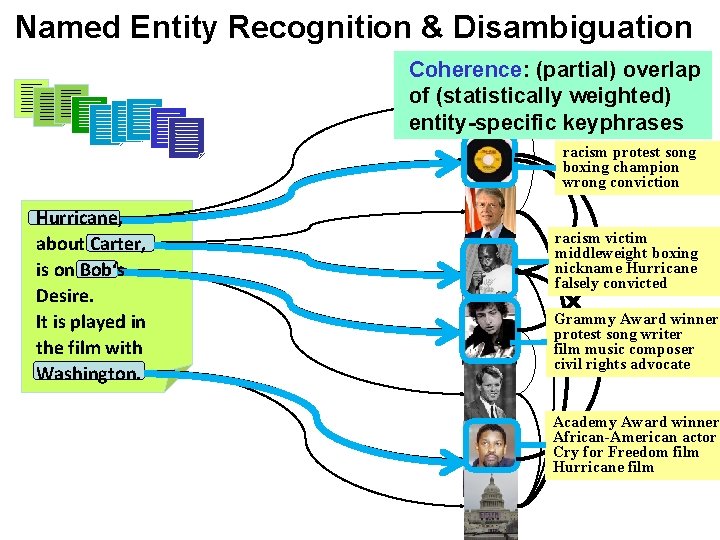
Named Entity Recognition & Disambiguation Coherence: (partial) overlap of (statistically weighted) entity-specific keyphrases racism protest song boxing champion wrong conviction Hurricane, about Carter, is on Bob‘s Desire. It is played in the film with Washington. racism victim middleweight boxing nickname Hurricane falsely convicted Grammy Award winner protest song writer film music composer civil rights advocate Academy Award winner African-American actor Cry for Freedom film Hurricane film

Named Entity Recognition & Disambiguation Hurricane, about Carter, is on Bob‘s Desire. It is played in the film with Washington. KB provides building blocks: • • NED algorithms compute mention-to-entity mapping over weighted graph of candidates by popularity & similarity & coherence name-entity dictionary, relationships, types, text descriptions, keyphrases, statistics for weights
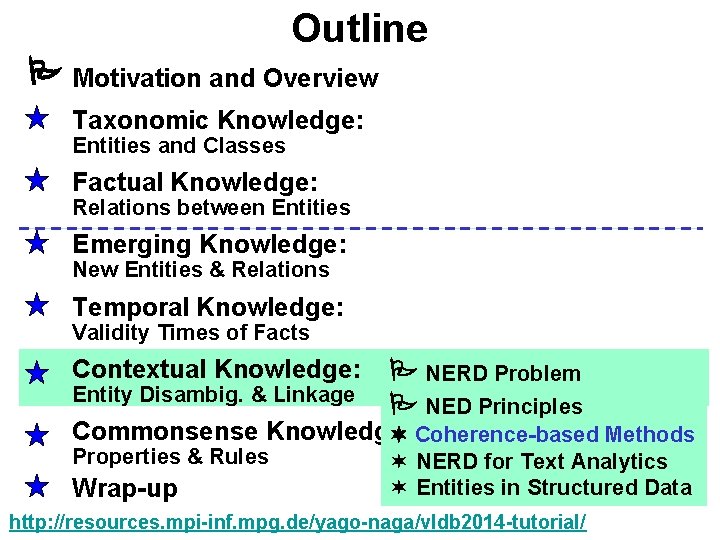
Outline Motivation and Overview Taxonomic Knowledge: Entities and Classes Factual Knowledge: Relations between Entities Emerging Knowledge: New Entities & Relations Temporal Knowledge: Validity Times of Facts Contextual Knowledge: Entity Disambig. & Linkage NERD Problem NED Principles Commonsense Knowledge: Coherence-based Methods Properties & Rules Wrap-up NERD for Text Analytics Entities in Structured Data http: //resources. mpi-inf. mpg. de/yago-naga/vldb 2014 -tutorial/
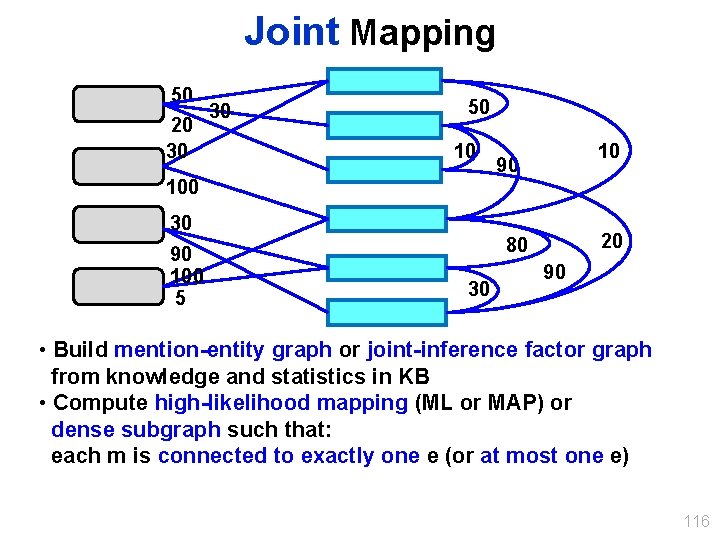
Joint Mapping 50 30 20 30 50 10 100 30 90 100 5 10 90 20 80 30 90 • Build mention-entity graph or joint-inference factor graph from knowledge and statistics in KB • Compute high-likelihood mapping (ML or MAP) or dense subgraph such that: each m is connected to exactly one e (or at most one e) 116
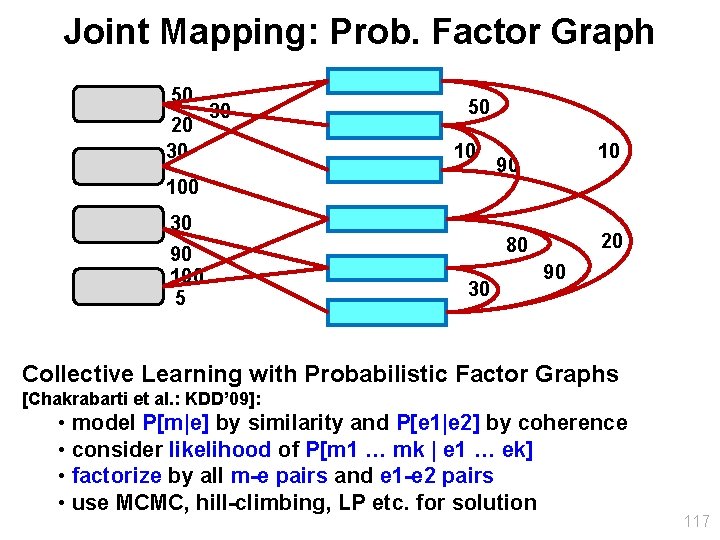
Joint Mapping: Prob. Factor Graph 50 30 20 30 50 10 100 30 90 100 5 10 90 20 80 30 90 Collective Learning with Probabilistic Factor Graphs [Chakrabarti et al. : KDD’ 09]: • model P[m|e] by similarity and P[e 1|e 2] by coherence • consider likelihood of P[m 1 … mk | e 1 … ek] • factorize by all m-e pairs and e 1 -e 2 pairs • use MCMC, hill-climbing, LP etc. for solution 117
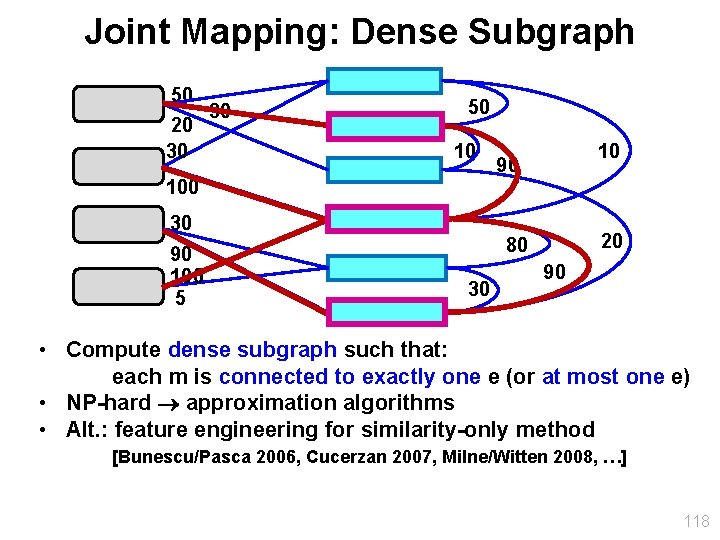
Joint Mapping: Dense Subgraph 50 30 20 30 50 10 100 30 90 100 5 10 90 20 80 30 90 • Compute dense subgraph such that: each m is connected to exactly one e (or at most one e) • NP-hard approximation algorithms • Alt. : feature engineering for similarity-only method [Bunescu/Pasca 2006, Cucerzan 2007, Milne/Witten 2008, …] 118
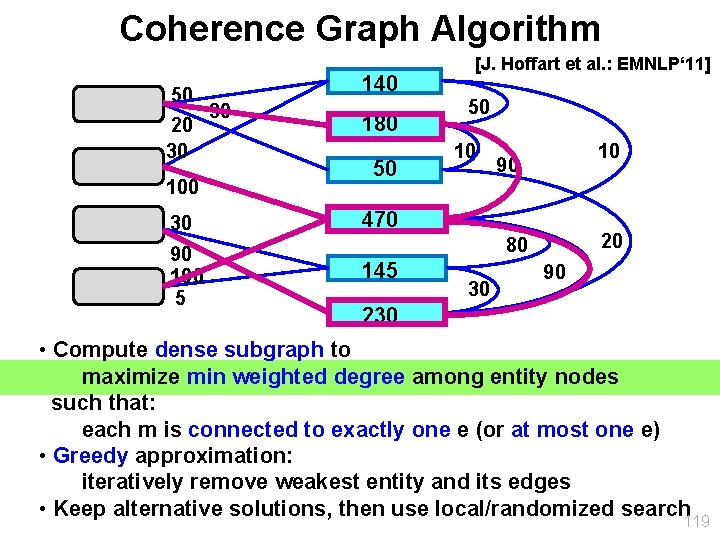
Coherence Graph Algorithm 50 30 20 30 100 140 180 50 30 470 90 100 5 145 [J. Hoffart et al. : EMNLP‘ 11] 50 10 10 90 20 80 30 90 230 • Compute dense subgraph to maximize min weighted degree among entity nodes such that: each m is connected to exactly one e (or at most one e) • Greedy approximation: iteratively remove weakest entity and its edges • Keep alternative solutions, then use local/randomized search 119
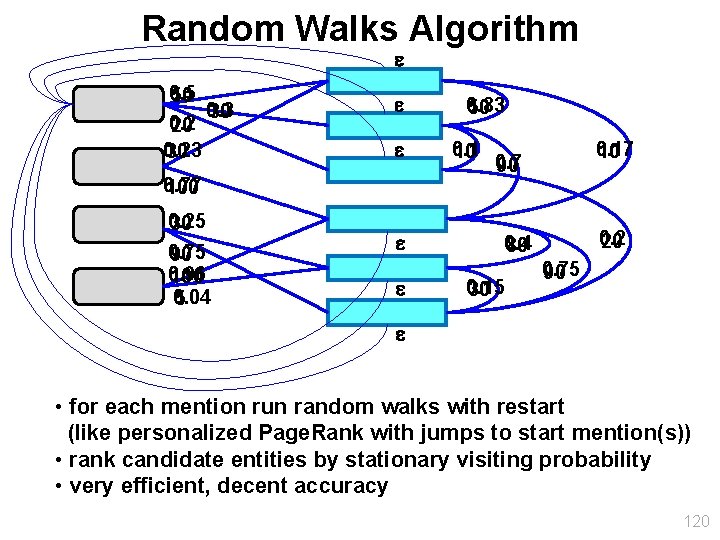
Random Walks Algorithm 0. 5 50 0. 3 30 0. 2 20 0. 23 30 0. 77 100 0. 25 30 0. 75 90 0. 96 100 0. 04 5 0. 83 50 0. 1 10 0. 17 10 0. 7 90 0. 2 20 0. 4 80 0. 15 30 0. 75 90 • for each mention run random walks with restart (like personalized Page. Rank with jumps to start mention(s)) • rank candidate entities by stationary visiting probability • very efficient, decent accuracy 120
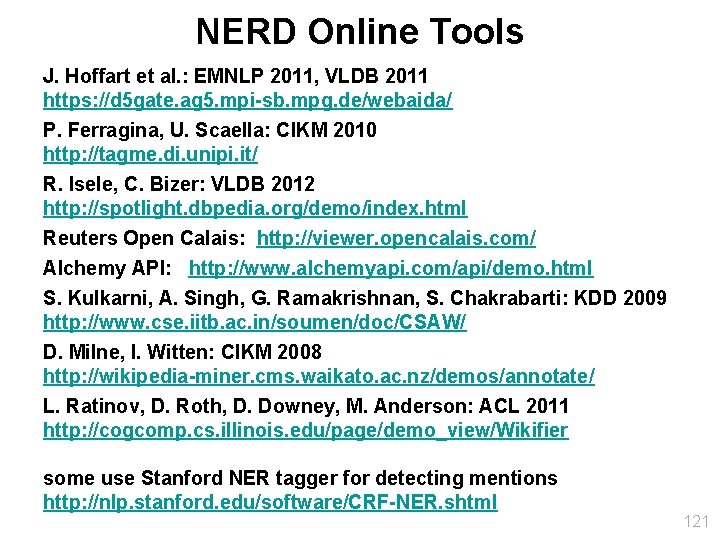
NERD Online Tools J. Hoffart et al. : EMNLP 2011, VLDB 2011 https: //d 5 gate. ag 5. mpi-sb. mpg. de/webaida/ P. Ferragina, U. Scaella: CIKM 2010 http: //tagme. di. unipi. it/ R. Isele, C. Bizer: VLDB 2012 http: //spotlight. dbpedia. org/demo/index. html Reuters Open Calais: http: //viewer. opencalais. com/ Alchemy API: http: //www. alchemyapi. com/api/demo. html S. Kulkarni, A. Singh, G. Ramakrishnan, S. Chakrabarti: KDD 2009 http: //www. cse. iitb. ac. in/soumen/doc/CSAW/ D. Milne, I. Witten: CIKM 2008 http: //wikipedia-miner. cms. waikato. ac. nz/demos/annotate/ L. Ratinov, D. Roth, D. Downey, M. Anderson: ACL 2011 http: //cogcomp. cs. illinois. edu/page/demo_view/Wikifier some use Stanford NER tagger for detecting mentions http: //nlp. stanford. edu/software/CRF-NER. shtml 121
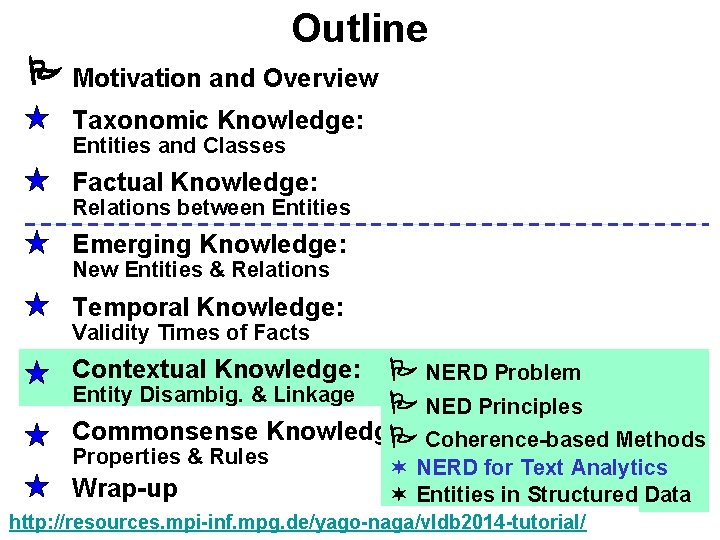
Outline Motivation and Overview Taxonomic Knowledge: Entities and Classes Factual Knowledge: Relations between Entities Emerging Knowledge: New Entities & Relations Temporal Knowledge: Validity Times of Facts Contextual Knowledge: NERD Problem Entity Disambig. & Linkage NED Principles Commonsense Knowledge: Coherence-based Methods Properties & Rules Wrap-up NERD for Text Analytics Entities in Structured Data http: //resources. mpi-inf. mpg. de/yago-naga/vldb 2014 -tutorial/

Use Case: Semantic Search over News stics. mpi-inf. mpg. de
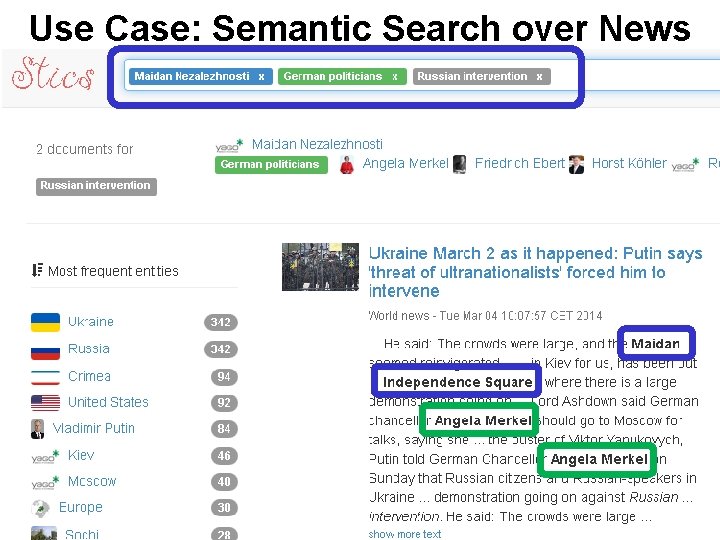
Use Case: Semantic Search over News
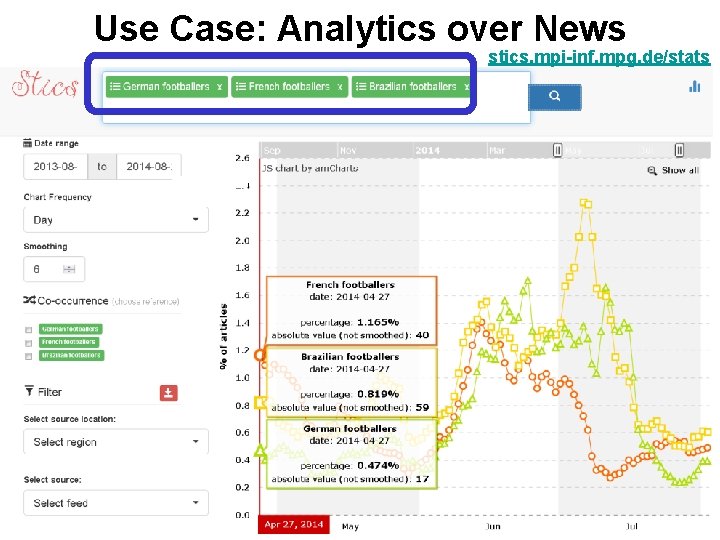
Use Case: Analytics over News stics. mpi-inf. mpg. de/stats
![Use Case: Semantic Culturomics [Suchanek&Preda: VLDB‘ 14] Age based on entity recognition & semantic Use Case: Semantic Culturomics [Suchanek&Preda: VLDB‘ 14] Age based on entity recognition & semantic](http://slidetodoc.com/presentation_image_h2/90103e2b31ead7cee92e6efcbcf159fd/image-126.jpg)
Use Case: Semantic Culturomics [Suchanek&Preda: VLDB‘ 14] Age based on entity recognition & semantic classes of KB over archive of Le Monde, 1945 -1985
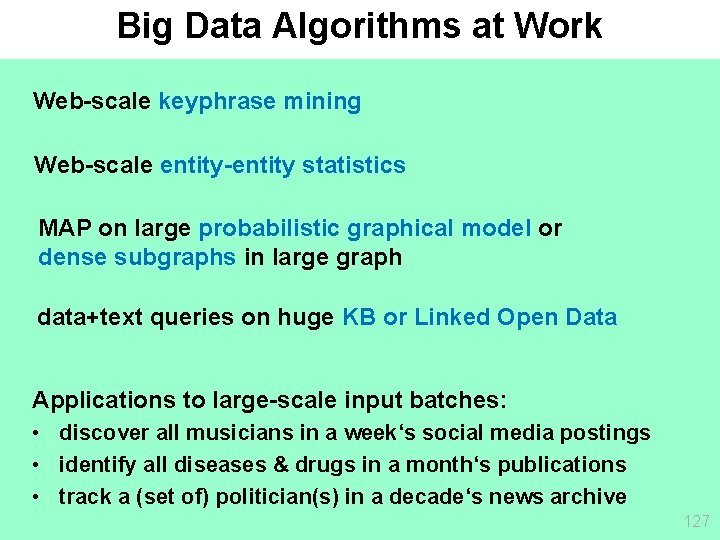
Big Data Algorithms at Work Web-scale keyphrase mining Web-scale entity-entity statistics MAP on large probabilistic graphical model or dense subgraphs in large graph data+text queries on huge KB or Linked Open Data Applications to large-scale input batches: • discover all musicians in a week‘s social media postings • identify all diseases & drugs in a month‘s publications • track a (set of) politician(s) in a decade‘s news archive 127
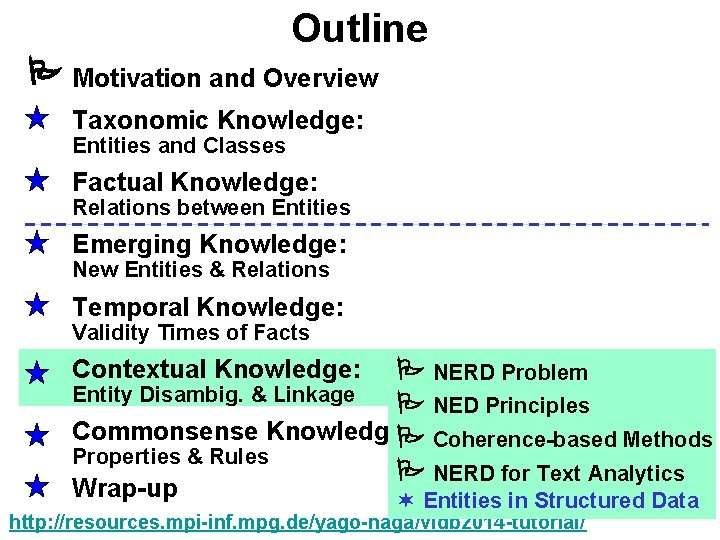
Outline Motivation and Overview Taxonomic Knowledge: Entities and Classes Factual Knowledge: Relations between Entities Emerging Knowledge: New Entities & Relations Temporal Knowledge: Validity Times of Facts Contextual Knowledge: NERD Problem Entity Disambig. & Linkage NED Principles Commonsense Knowledge: Coherence-based Methods Properties & Rules NERD for Text Analytics Wrap-up Entities in Structured Data http: //resources. mpi-inf. mpg. de/yago-naga/vldb 2014 -tutorial/
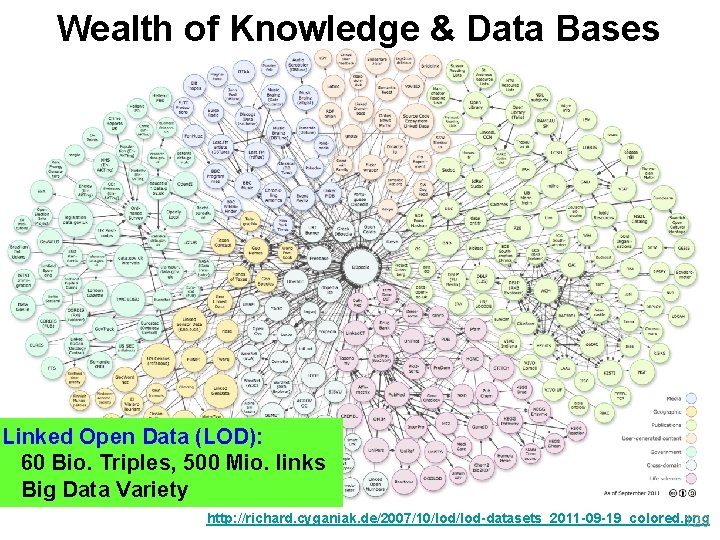
Wealth of Knowledge & Data Bases Linked Open Data (LOD): 60 Bio. Triples, 500 Mio. links Big Data Variety http: //richard. cyganiak. de/2007/10/lod-datasets_2011 -09 -19_colored. png 129
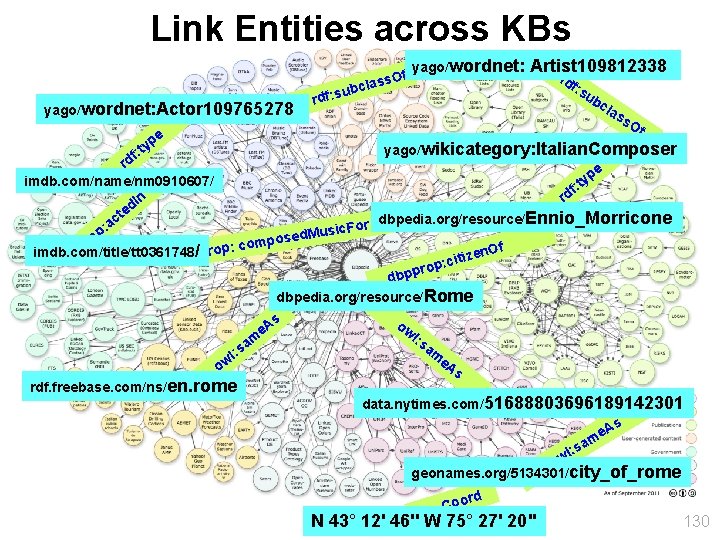
Link Entities across KBs yago/wordnet: Actor 109765278 yago/wordnet: f ass. O Artist 109812338 rd rd f: s cl f: sub ub cla ss e yp Of yago/wikicategory: Italian. Composer f: t d r pe y imdb. com/name/nm 0910607/ f: t d n r I ed t ac r dbpedia. org/resource/Ennio_Morricone o : F c i s u p posed. M ro m o c p : n. Of imdb. com/title/tt 0361748/prop e z i t ci rop: p p db dbpedia. org/resource/Rome s m e. A ow a l: s rdf. freebase. com/ns/en. rome ow l: s am e. A s data. nytimes. com/51688803696189142301 As e m : sa l ow geonames. org/5134301/city_of_rome rd Coo N 43° 12' 46'' W 75° 27' 20'' 130
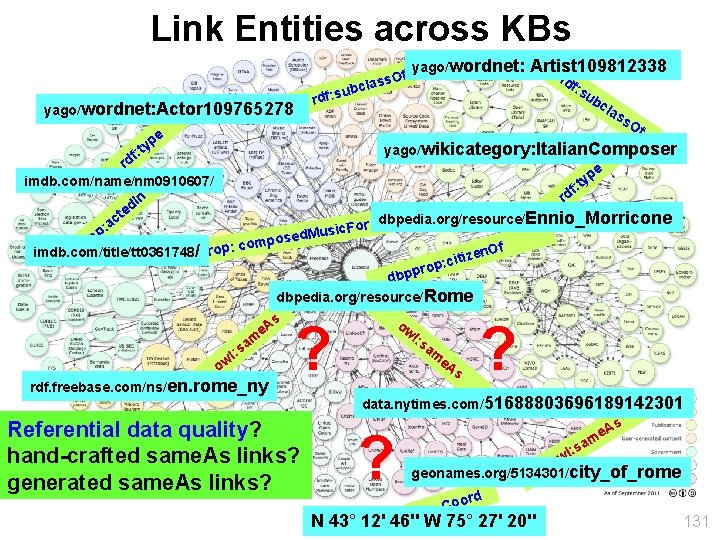
Link Entities across KBs yago/wordnet: f ass. O Artist 109812338 rd yago/wordnet: Actor 109765278 rd f: s cl f: sub ub cla ss e yp Of yago/wikicategory: Italian. Composer f: t d r pe y imdb. com/name/nm 0910607/ f: t d n r I ed t ac r dbpedia. org/resource/Ennio_Morricone o : F c i s u p posed. M ro m o c p : n. Of imdb. com/title/tt 0361748/prop e z i t ci rop: p p db dbpedia. org/resource/Rome s e. A am l: s ow rdf. freebase. com/ns/en. rome_ny ow ? Referential data quality? hand-crafted same. As links? generated same. As links? ? l: s am e. A s data. nytimes. com/51688803696189142301 As e m : sa l ow geonames. org/5134301/city_of_rome ? rd Coo N 43° 12' 46'' W 75° 27' 20'' 131
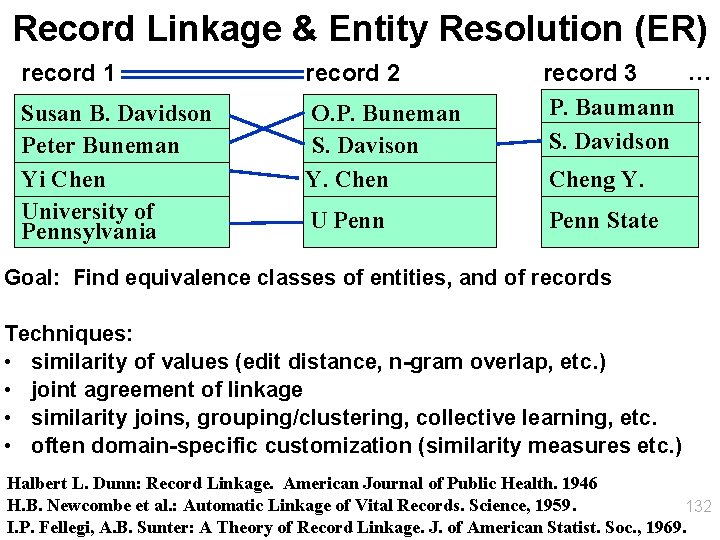
Record Linkage & Entity Resolution (ER) record 1 record 2 Susan B. Davidson Peter Buneman Yi Chen University of Pennsylvania O. P. Buneman S. Davison Y. Chen U Penn … record 3 P. Baumann S. Davidson Cheng Y. Penn State Goal: Find equivalence classes of entities, and of records Techniques: • similarity of values (edit distance, n-gram overlap, etc. ) • joint agreement of linkage • similarity joins, grouping/clustering, collective learning, etc. • often domain-specific customization (similarity measures etc. ) Halbert L. Dunn: Record Linkage. American Journal of Public Health. 1946 H. B. Newcombe et al. : Automatic Linkage of Vital Records. Science, 1959. 132 I. P. Fellegi, A. B. Sunter: A Theory of Record Linkage. J. of American Statist. Soc. , 1969.
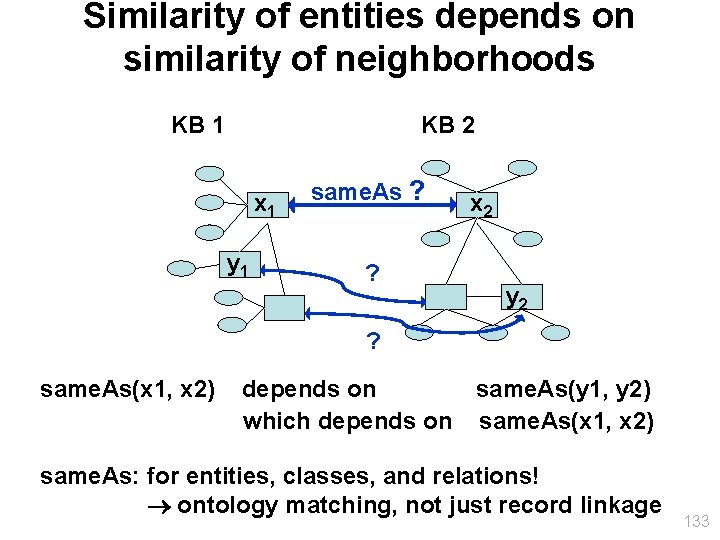
Similarity of entities depends on similarity of neighborhoods KB 1 KB 2 x 1 y 1 same. As ? ? x 2 y 2 ? same. As(x 1, x 2) depends on same. As(y 1, y 2) which depends on same. As(x 1, x 2) same. As: for entities, classes, and relations! ontology matching, not just record linkage 133
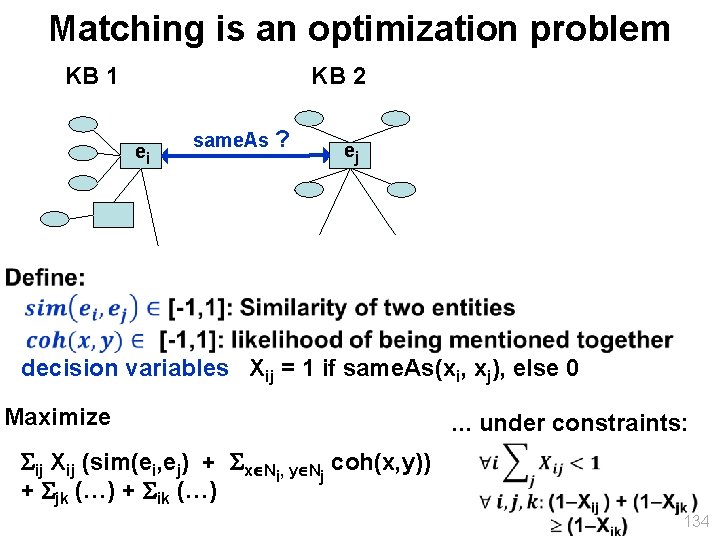
Matching is an optimization problem KB 1 KB 2 ei same. As ? ej decision variables Xij = 1 if same. As(xi, xj), else 0 Maximize . . . under constraints: ij Xij (sim(ei, ej) + x Ni, y Nj coh(x, y)) + jk (…) + ik (…) 134
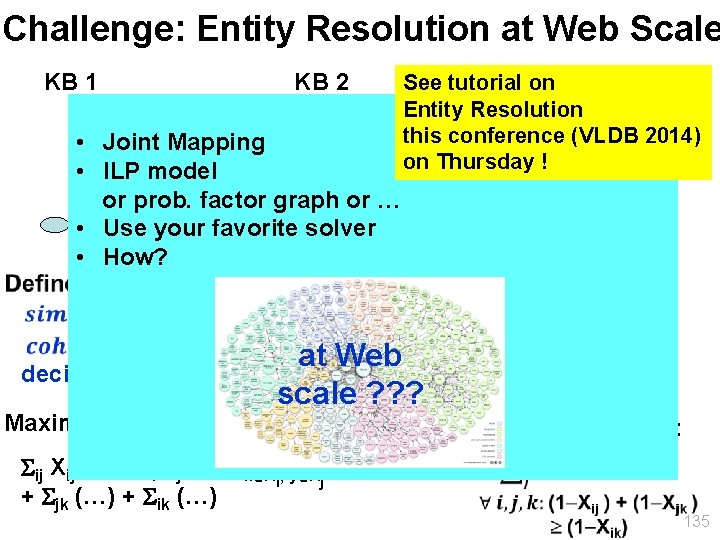
Challenge: Entity Resolution at Web Scale KB 1 KB 2 • Joint Mapping same. As ? ej ei • ILP model or prob. factor graph or … • Use your favorite solver • How? decision variables Maximize See tutorial on Entity Resolution this conference (VLDB 2014) on Thursday ! at Web Xij = 1 if same. As(xi, xj), else 0 scale ? ? ? ij Xij (sim(ei, ej) + x Ni, y Nj coh(x, y)) + jk (…) + ik (…) . . . under constraints: 135
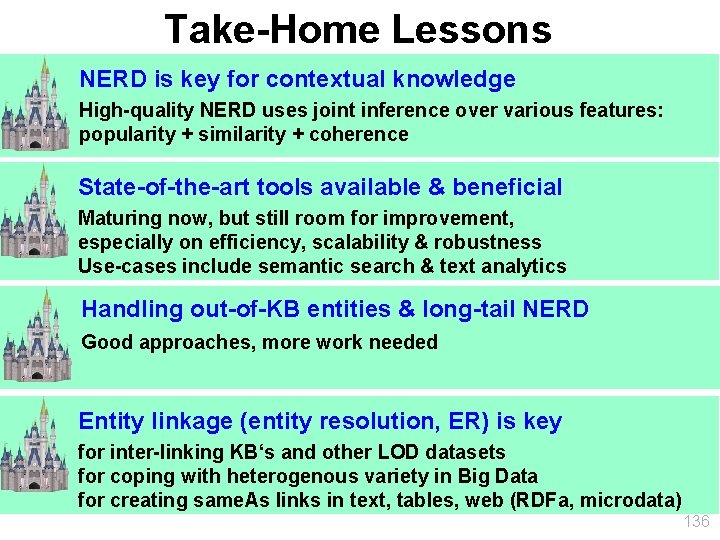
Take-Home Lessons NERD is key for contextual knowledge High-quality NERD uses joint inference over various features: popularity + similarity + coherence State-of-the-art tools available & beneficial Maturing now, but still room for improvement, especially on efficiency, scalability & robustness Use-cases include semantic search & text analytics Handling out-of-KB entities & long-tail NERD Good approaches, more work needed Entity linkage (entity resolution, ER) is key for inter-linking KB‘s and other LOD datasets for coping with heterogenous variety in Big Data for creating same. As links in text, tables, web (RDFa, microdata) 136
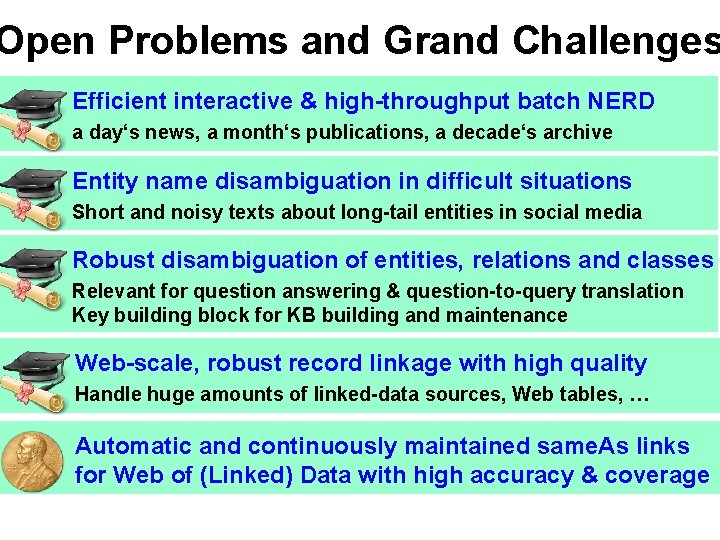
Open Problems and Grand Challenges Efficient interactive & high-throughput batch NERD a day‘s news, a month‘s publications, a decade‘s archive Entity name disambiguation in difficult situations Short and noisy texts about long-tail entities in social media Robust disambiguation of entities, relations and classes Relevant for question answering & question-to-query translation Key building block for KB building and maintenance Web-scale, robust record linkage with high quality Handle huge amounts of linked-data sources, Web tables, … Automatic and continuously maintained same. As links for Web of (Linked) Data with high accuracy & coverage
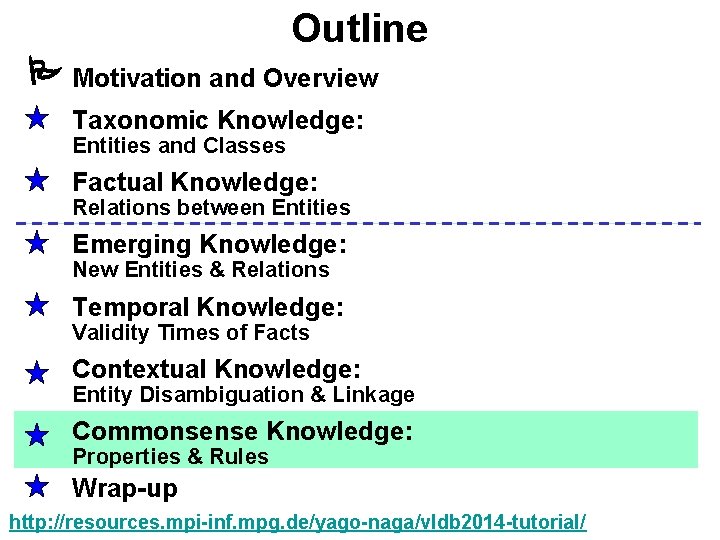
Outline Motivation and Overview Taxonomic Knowledge: Entities and Classes Factual Knowledge: Relations between Entities Emerging Knowledge: New Entities & Relations Temporal Knowledge: Validity Times of Facts Contextual Knowledge: Entity Disambiguation & Linkage Commonsense Knowledge: Properties & Rules Wrap-up http: //resources. mpi-inf. mpg. de/yago-naga/vldb 2014 -tutorial/
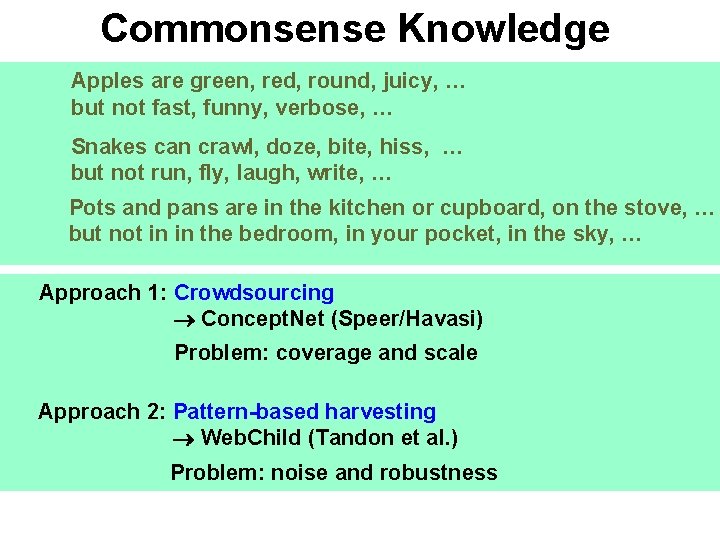
Commonsense Knowledge Apples are green, red, round, juicy, … but not fast, funny, verbose, … Snakes can crawl, doze, bite, hiss, … but not run, fly, laugh, write, … Pots and pans are in the kitchen or cupboard, on the stove, … but not in in the bedroom, in your pocket, in the sky, … Approach 1: Crowdsourcing Concept. Net (Speer/Havasi) Problem: coverage and scale Approach 2: Pattern-based harvesting Web. Child (Tandon et al. ) Problem: noise and robustness
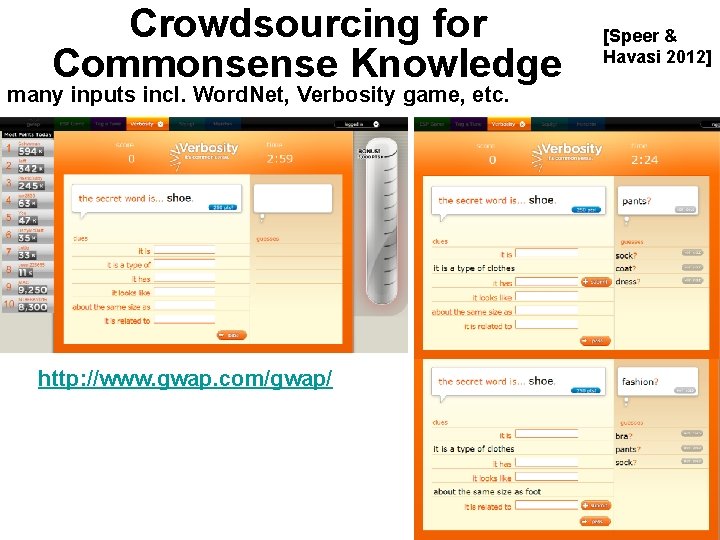
Crowdsourcing for Commonsense Knowledge many inputs incl. Word. Net, Verbosity game, etc. http: //www. gwap. com/gwap/ [Speer & Havasi 2012]
![Crowdsourcing for Commonsense Knowledge [Speer & Havasi 2012] many inputs incl. Word. Net, Verbosity Crowdsourcing for Commonsense Knowledge [Speer & Havasi 2012] many inputs incl. Word. Net, Verbosity](http://slidetodoc.com/presentation_image_h2/90103e2b31ead7cee92e6efcbcf159fd/image-141.jpg)
Crowdsourcing for Commonsense Knowledge [Speer & Havasi 2012] many inputs incl. Word. Net, Verbosity game, etc. Concept. Net 5: 3. 9 Mio concepts 12. 5 Mio. edges http: //conceptnet 5. media. mit. edu/
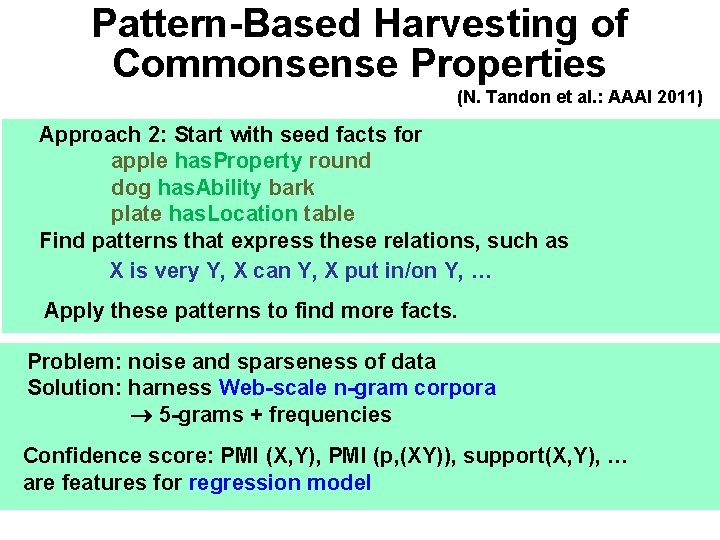
Pattern-Based Harvesting of Commonsense Properties (N. Tandon et al. : AAAI 2011) Approach 2: Start with seed facts for apple has. Property round dog has. Ability bark plate has. Location table Find patterns that express these relations, such as X is very Y, X can Y, X put in/on Y, … Apply these patterns to find more facts. Problem: noise and sparseness of data Solution: harness Web-scale n-gram corpora 5 -grams + frequencies Confidence score: PMI (X, Y), PMI (p, (XY)), support(X, Y), … are features for regression model
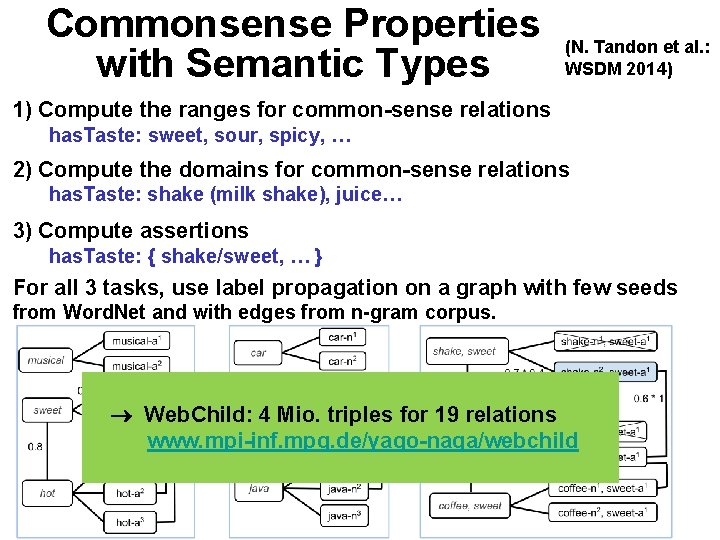
Commonsense Properties with Semantic Types (N. Tandon et al. : WSDM 2014) 1) Compute the ranges for common-sense relations has. Taste: sweet, sour, spicy, … 2) Compute the domains for common-sense relations has. Taste: shake (milk shake), juice… 3) Compute assertions has. Taste: { shake/sweet, … } For all 3 tasks, use label propagation on a graph with few seeds from Word. Net and with edges from n-gram corpus. Web. Child: 4 Mio. triples for 19 relations www. mpi-inf. mpg. de/yago-naga/webchild
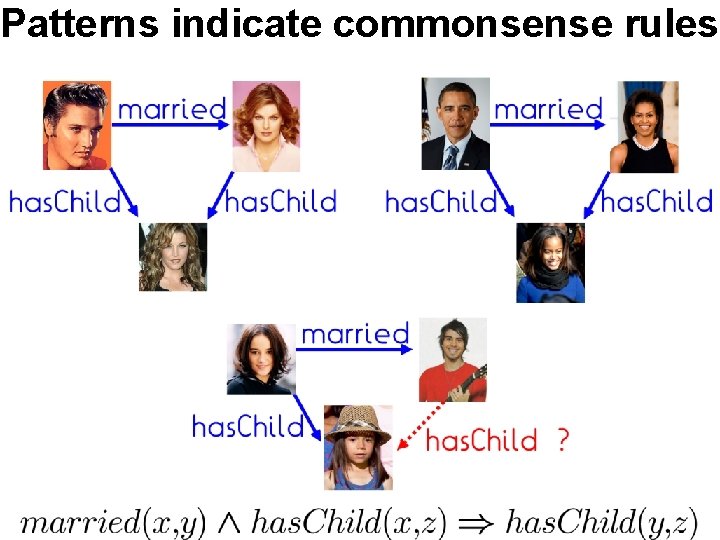
Patterns indicate commonsense rules
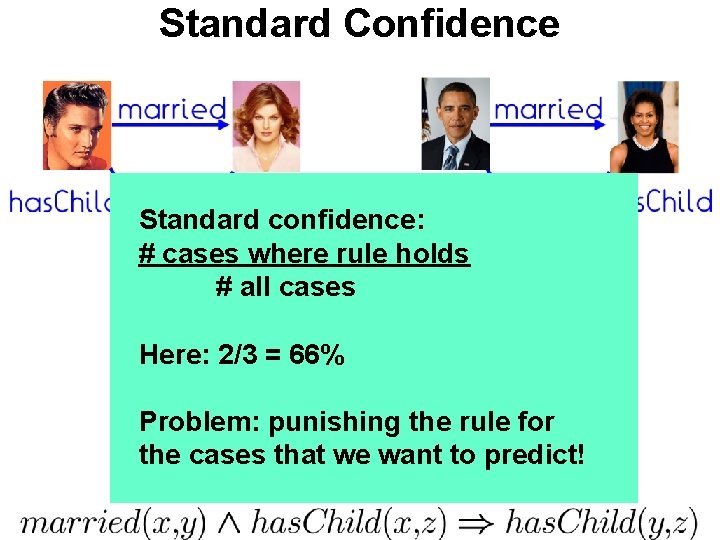
Standard Confidence Standard confidence: # cases where rule holds # all cases Here: 2/3 = 66% Problem: punishing the rule for the cases that we want to predict!
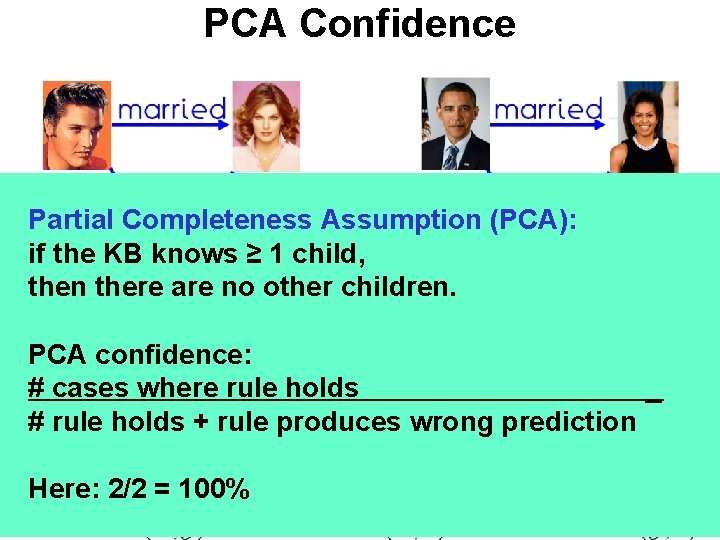
PCA Confidence Partial Completeness Assumption (PCA): if the KB knows ≥ 1 child, then there are no other children. PCA confidence: # cases where rule holds _ # rule holds + rule produces wrong prediction Here: 2/2 = 100%
![AMIE: Rule mining on KBs [Galarraga et al. : WWW’ 13] AMIE: Rule mining on KBs [Galarraga et al. : WWW’ 13]](http://slidetodoc.com/presentation_image_h2/90103e2b31ead7cee92e6efcbcf159fd/image-147.jpg)
AMIE: Rule mining on KBs [Galarraga et al. : WWW’ 13]
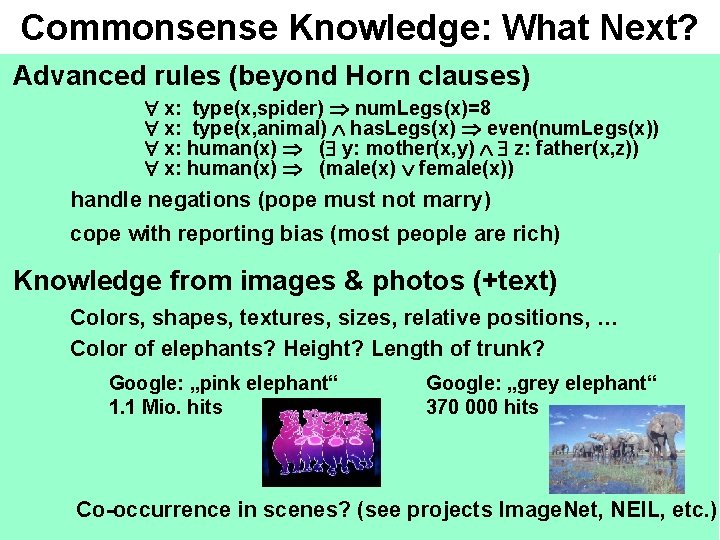
Commonsense Knowledge: What Next? Advanced rules (beyond Horn clauses) x: type(x, spider) num. Legs(x)=8 x: type(x, animal) has. Legs(x) even(num. Legs(x)) x: human(x) ( y: mother(x, y) z: father(x, z)) x: human(x) (male(x) female(x)) handle negations (pope must not marry) cope with reporting bias (most people are rich) Knowledge from images & photos (+text) Colors, shapes, textures, sizes, relative positions, … Color of elephants? Height? Length of trunk? Google: „pink elephant“ 1. 1 Mio. hits Google: „grey elephant“ 370 000 hits Co-occurrence in scenes? (see projects Image. Net, NEIL, etc. )
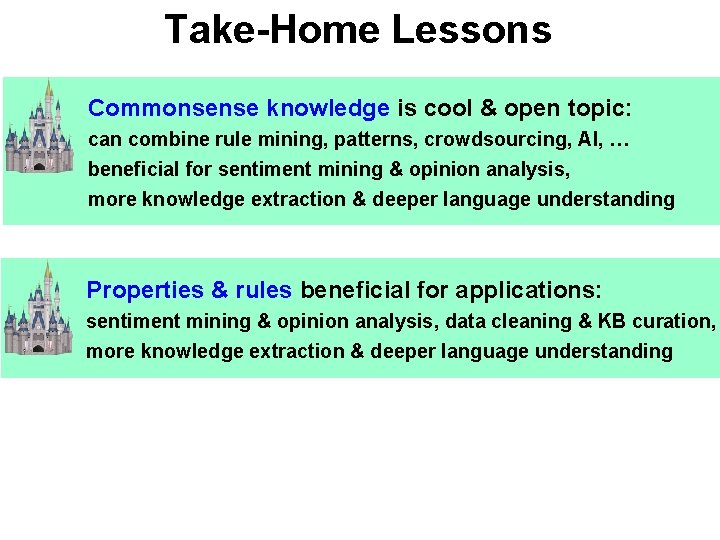
Take-Home Lessons Commonsense knowledge is cool & open topic: can combine rule mining, patterns, crowdsourcing, AI, … beneficial for sentiment mining & opinion analysis, more knowledge extraction & deeper language understanding Properties & rules beneficial for applications: sentiment mining & opinion analysis, data cleaning & KB curation, more knowledge extraction & deeper language understanding
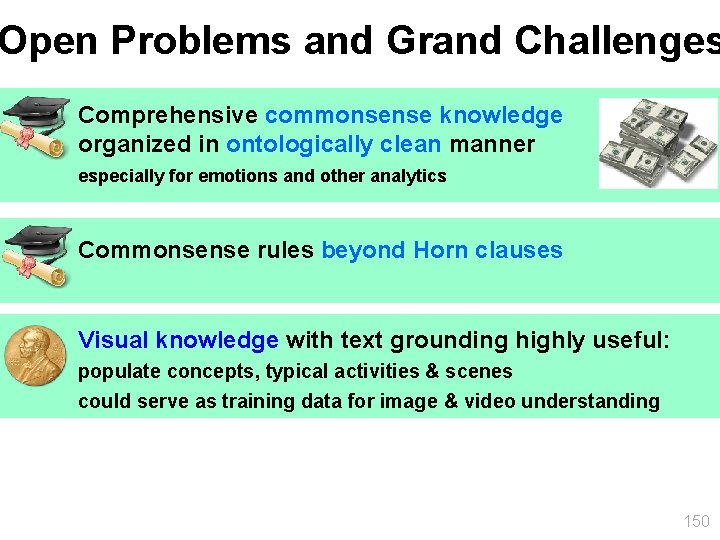
Open Problems and Grand Challenges Comprehensive commonsense knowledge organized in ontologically clean manner especially for emotions and other analytics Commonsense rules beyond Horn clauses Visual knowledge with text grounding highly useful: populate concepts, typical activities & scenes could serve as training data for image & video understanding 150
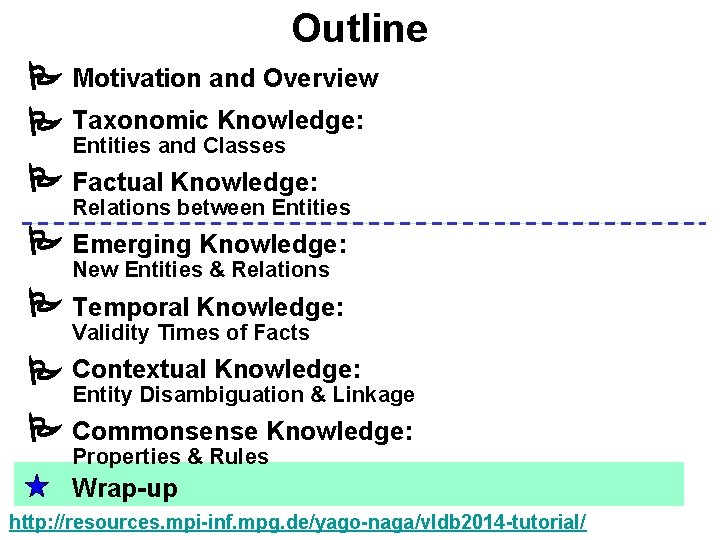
Outline Motivation and Overview Taxonomic Knowledge: Entities and Classes Factual Knowledge: Relations between Entities Emerging Knowledge: New Entities & Relations Temporal Knowledge: Validity Times of Facts Contextual Knowledge: Entity Disambiguation & Linkage Commonsense Knowledge: Properties & Rules Wrap-up http: //resources. mpi-inf. mpg. de/yago-naga/vldb 2014 -tutorial/
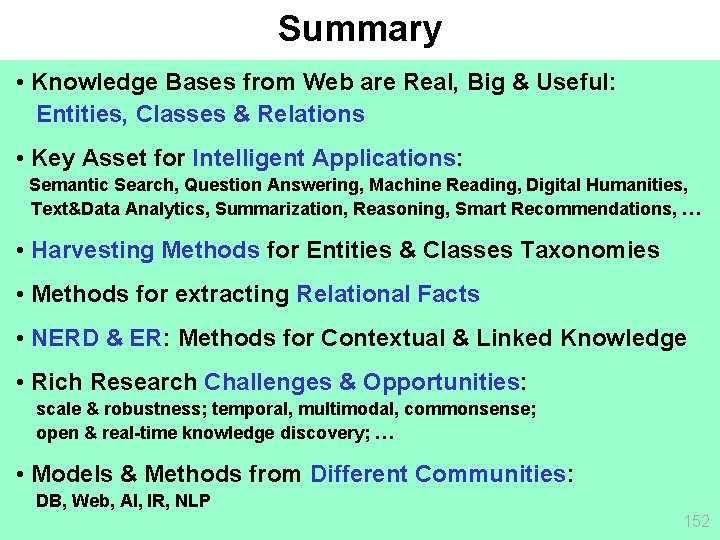
Summary • Knowledge Bases from Web are Real, Big & Useful: Entities, Classes & Relations • Key Asset for Intelligent Applications: Semantic Search, Question Answering, Machine Reading, Digital Humanities, Text&Data Analytics, Summarization, Reasoning, Smart Recommendations, … • Harvesting Methods for Entities & Classes Taxonomies • Methods for extracting Relational Facts • NERD & ER: Methods for Contextual & Linked Knowledge • Rich Research Challenges & Opportunities: scale & robustness; temporal, multimodal, commonsense; open & real-time knowledge discovery; … • Models & Methods from Different Communities: DB, Web, AI, IR, NLP 152
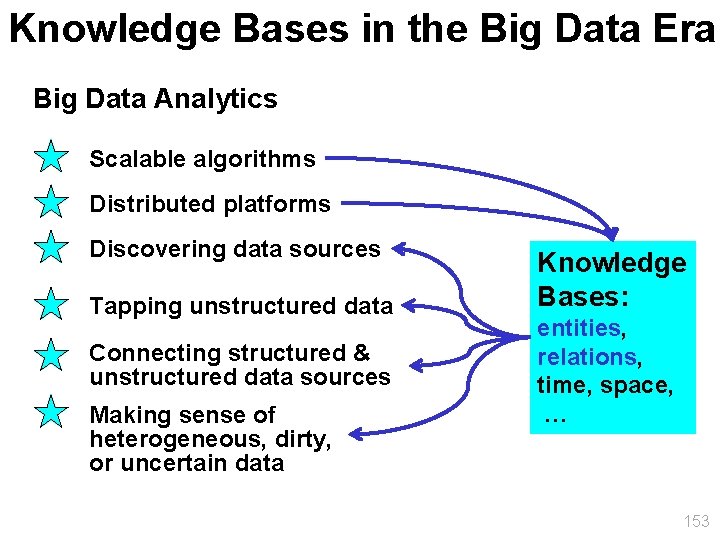
Knowledge Bases in the Big Data Era Big Data Analytics Scalable algorithms Distributed platforms Discovering data sources Tapping unstructured data Connecting structured & unstructured data sources Making sense of heterogeneous, dirty, or uncertain data Knowledge Bases: entities, relations, time, space, … 153
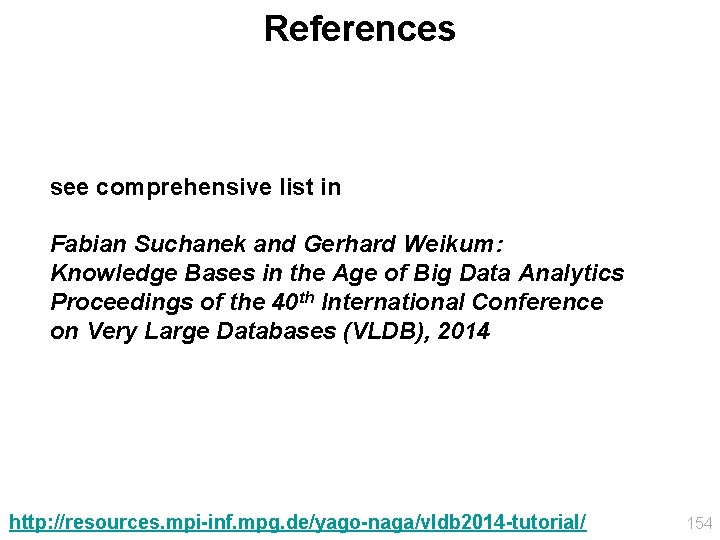
References see comprehensive list in Fabian Suchanek and Gerhard Weikum: Knowledge Bases in the Age of Big Data Analytics Proceedings of the 40 th International Conference on Very Large Databases (VLDB), 2014 http: //resources. mpi-inf. mpg. de/yago-naga/vldb 2014 -tutorial/ 154
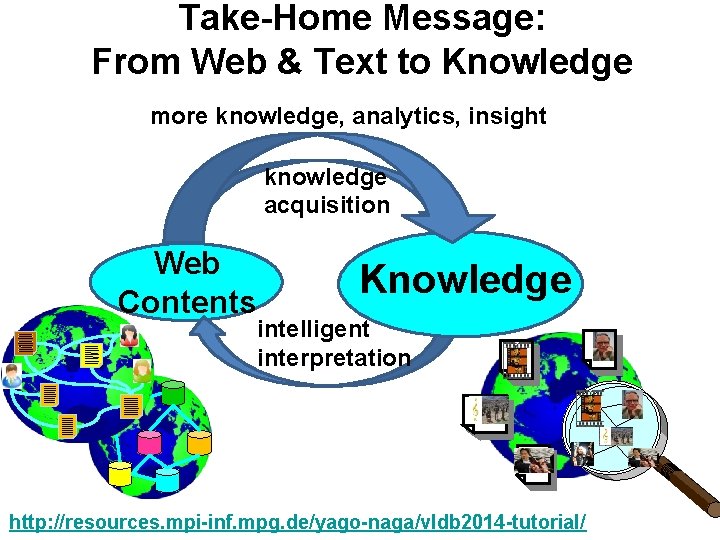
Take-Home Message: From Web & Text to Knowledge more knowledge, analytics, insight knowledge acquisition Web Contents Knowledge intelligent interpretation http: //resources. mpi-inf. mpg. de/yago-naga/vldb 2014 -tutorial/
- Slides: 155